In the last year I have had a number of issues with items in or on Grace’s mast. During a recent trip to Blake Island, the anchor light stopped working, and that was the last straw. It was time to dig deeper into fixing all of the issues.
By this time, I had the following problems:
VHF quality issues – I continued to have very bad quality when transmitting (almost unusable) and poor reception when receiving as well. I had replaced the cable inside the cabin, ends, and even had a friend test the cable.
Anchor light tripping circuit breaker – weirdly, every time I tried to turn on the anchor light, it tripped the circuit breaker. This indicated either a wiring fault, or something very bad with the bulb. I believed the bulb was LED.
Raymarine wind failures – the ST60 wind instrument was giving very odd readings. At times, it would show no wind when there definitely was. Multiple observations over a month showed that the anemometer portion of the instrument wasn’t spinning as fast as it should, and likely was worn out or in need of maintenance.
Steaming light failed – this light failed late last year. It is part of a Forespar combo steaming / deck light.
Investigation
I wanted to understand more about the failures. Were these failures related in some way, or was this just from years of use without much maintenance?
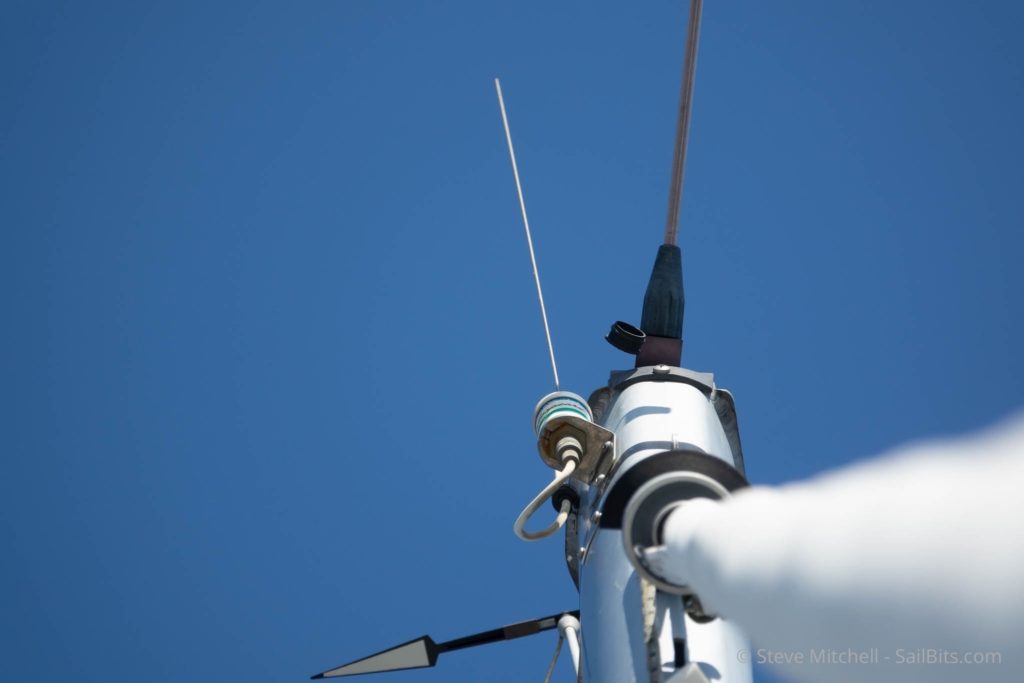
The VHF issues appeared to be centered mostly on the cable. I had a friend who is well versed in antennas and cabling visit and test the cable from the base of the mast to the antenna, and it had an SWR of 42! That is very, very bad. Even replacing the ends as I had done before didn’t make a difference.
The anchor light was a mystery. I tested the wiring internally below the mast, and everything was fine. Using a Fluke meter, I was able to see what I expected to be a correct resistance level when testing the wiring from the base of the mast to the top. Clearly there was a short somewhere, but the way things behaved didn’t make sense.
The wind instrument was clearly in need of maintenance. Using online instructions to test the signal proved that it was definitely working correctly and wasn’t failing at the sensor level. I guessed that over time the bearings had gotten fouled or just needed to be lubricated. There’s a great post on YBW.com on how to take apart, clean, and lubricate the whole setup. Still, I had been considering replacing it with a NMEA 2000 or more modern device the next time I had the chance.
The steaming light was pretty obvious – as far as I can tell, the previous owner (or someone else) used an off the shelf home extension cable, cut the ends off of it, and used that inside the mast. It was badly corroded and was clearly not made to be in a marine environment. To make matters worse, the cable slapped inside the mast constantly when the boat moved, as it had never been secured. Additionally, this fixture was an older Forespar combo unit which used standard bulbs, and likely the steaming bulb had gone out.
Given that I wanted to replace the steaming/deck light cable, and had to replace the VHF cable, my investigation pointed towards replacing all wiring and cables while I was at it. It was likely easier to do that than leaving existing cabling and running new ones side to side.
One of the challenges was how the cabling was run – was it all inside a conduit inside the mast? How was it secured, if at all? Was there one conduit running all the way up, or more than one?
I posted in two areas that I have had excellent luck for my model of Beneteau – SailboatOwners.com and the Beneteau 311 Facebook group, which I just handily happen to be the administrator of. I started a thread about pulling wires for a 311 Beneteau mast on SailBoatOwners and got some good pictures and advice from members. The best feedback was from the Facebook group, including pictures of the top of the mast, suggestions for what is inside, and more.
In addition, I was able to look into the inside of the mast with a flashlight and could only see one conduit, and the loose extension cable up to the steaming/deck light.
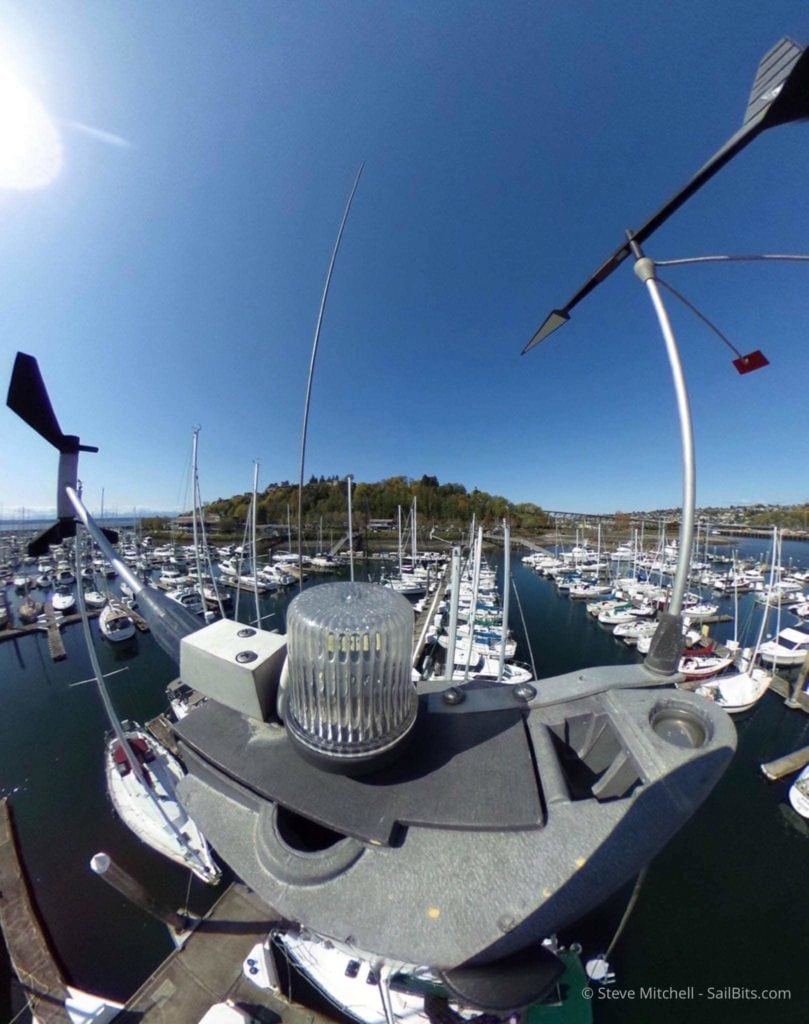
To get more information, I rigged up my Ricoh Theta 360 camera on a halyard and took some pictures of the top of the mast. This was extremely helpful, and allowed me to see everything that was at the top and plan both space and setup. Quite a handy way of getting pictures of the top of your mast!
Some folks suggested I use my drone to get pictures, but Elliott Bay Marina is well within range of the Kenmore Air base on Lake Union, which requires notifying ATC and the airport, and close enough to many other restricted areas that I would rather not.
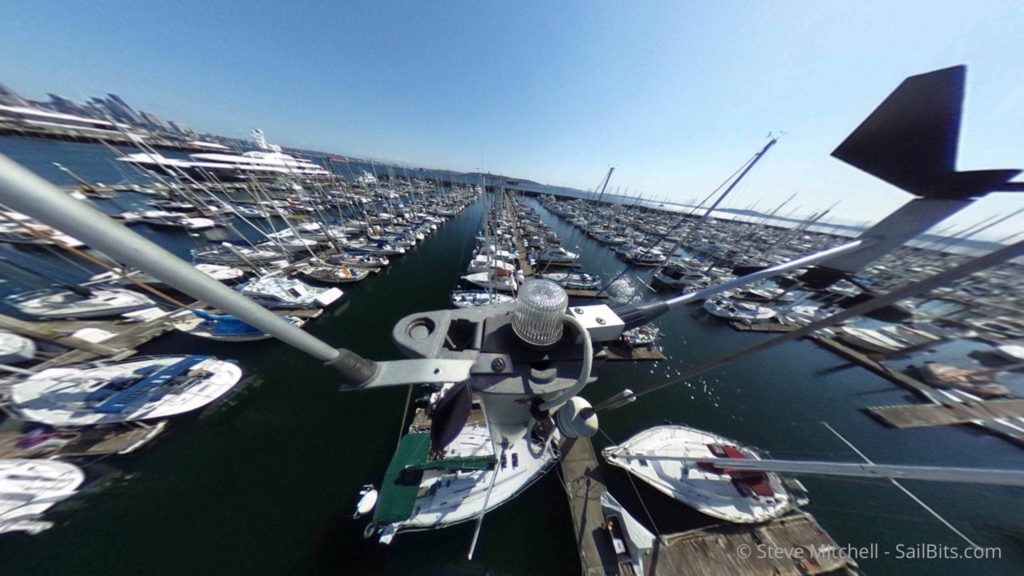
Planning
My first idea to solve all these problems was to pay someone to climb the mast, remove the broken stuff, pull wire, job done. The wire pulling was the part that I wasn’t too sure about, and after some investigation, I didn’t think it would work out. The wiring takes a sharp 90 degree turn as it comes out of the bottom of the mast, and who knows what it looks like at the top.
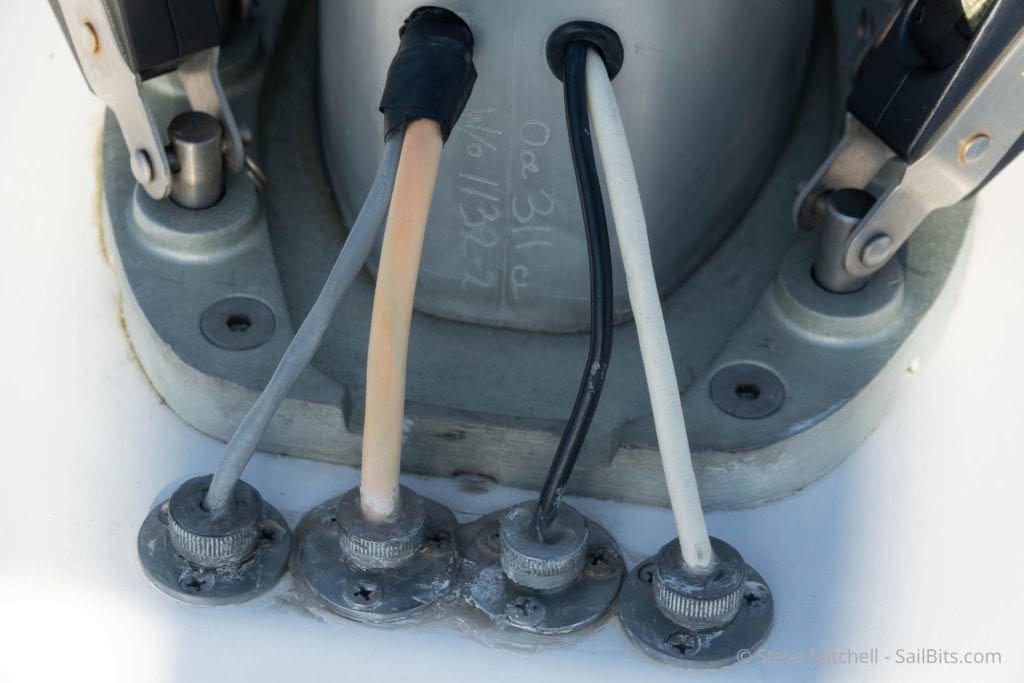
After a lot of thinking, I decided that the best way to solve all of these issues was take the mast down and do the work in a yard. It was a big decision, as I have not done this on Grace, and only two other times on other boats, and I was a bit nervous.
With that decision made, it was time to come up with a plan for attacking work. I wanted to do the majority of it myself mainly for time savings and to ensure it was done right. I always prefer to do my own work so that I know how it has been done, and can troubleshoot things in the future if need be.
I figured I could do everything in 3 days – first day to drop the mast and examine things, second day to do the majority of the work, and the third to finalize things and put the mast back up. It was aggressive, but I was pretty sure I could do it.
Upgrades and Updates
VHF Antenna and Cable
I was able to take long zoom photos of the current antenna, and found out it was a Shakespeare 5215 model. I didn’t see any reason to choose something different, as they are light, resilient, and good performers. Plus, the existing bracket already on the mast should be good for the new one.
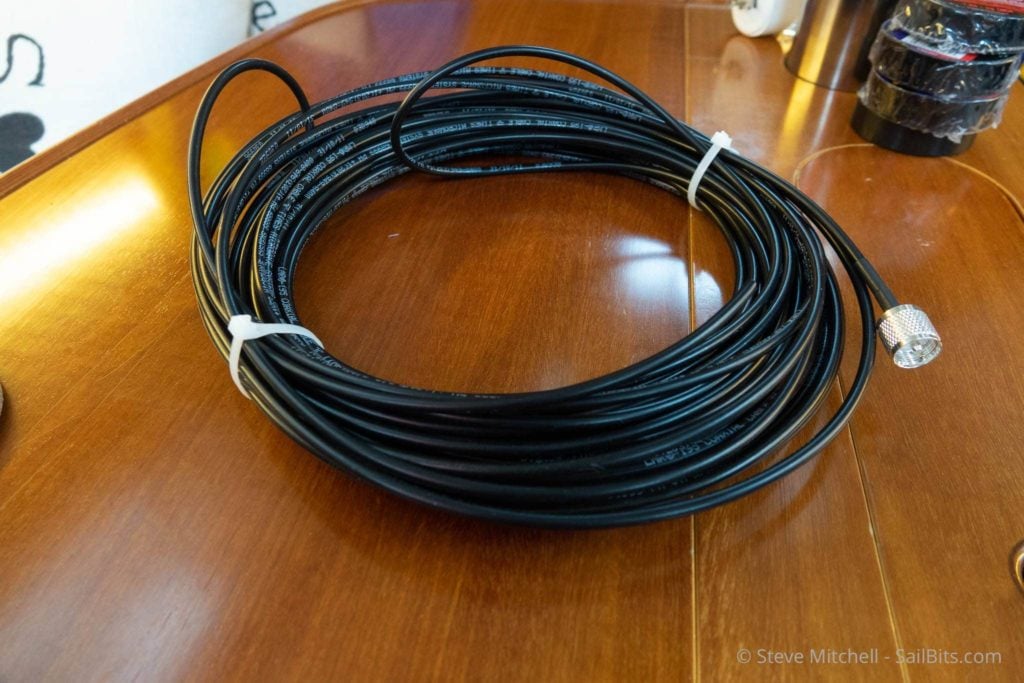
For cabling, I chatted with a friend well versed in antennas, and he suggested LMR-195, which is not a type I am used to in the marine world. However, it has great specs, albeit slightly less flexible than the usual RG-8. The plan was to run a single wire from the antenna all the way down the mast, through the hull, and to the VHF radio.
Anchor Light
A friend recommended the LunaSea LED anchor light, and it looked perfect for my use. Not only is it LED, but it uses glass instead of plastic for the light itself, and machined aluminum for the rest of the housing – very well built. In addition, it has a very sharp bird spike that can be removed, and you can put your Windex there instead if you choose. The light is also rated to have very low, if not zero, EMI for things like a VHF antenna. No compatibility concerns there.
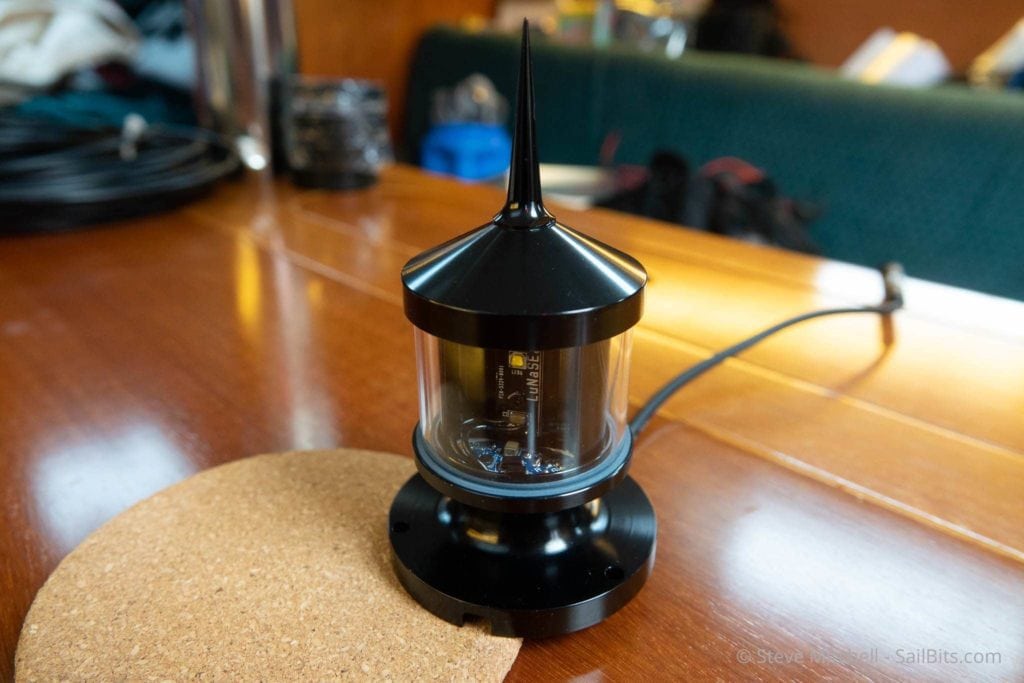
The light can not only be used as an anchor light, but as an SOS emergency light as well.
Steaming and Deck Light
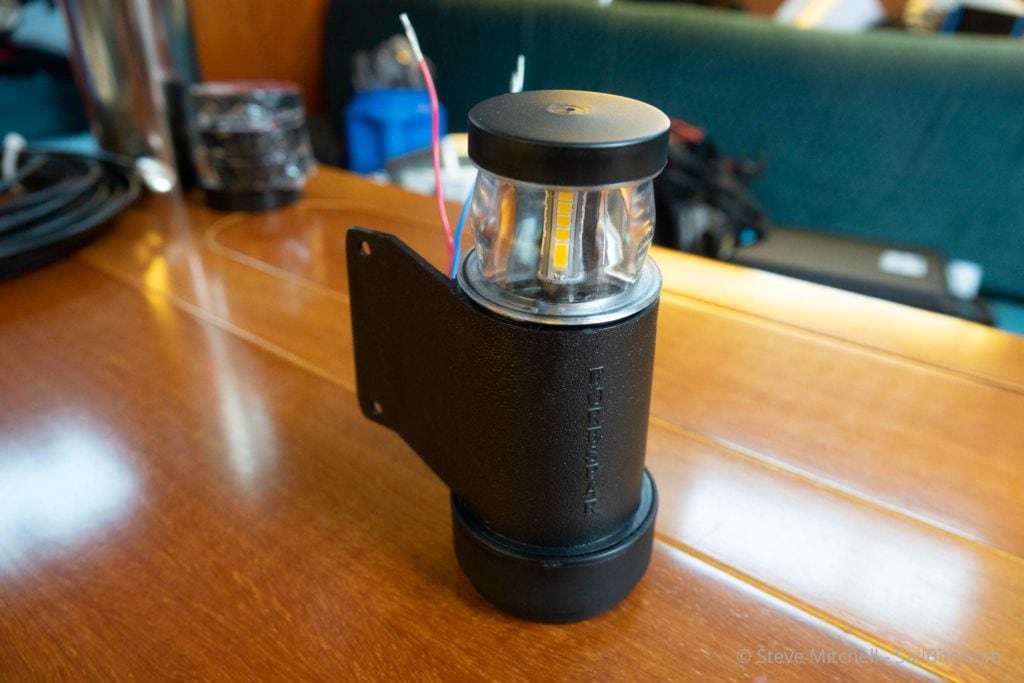
I found a great LED staging and deck light from Forespar that looked very close to the original. The steaming light was a more amber white LED color, while the deck light was very bright white LEDs. It has three wires and the ability to separate out turning one or the other on, which my current setup did not have. This was great since I definitely want to be able to have the steaming light on while not having the deck lit up and my night vision compromised.
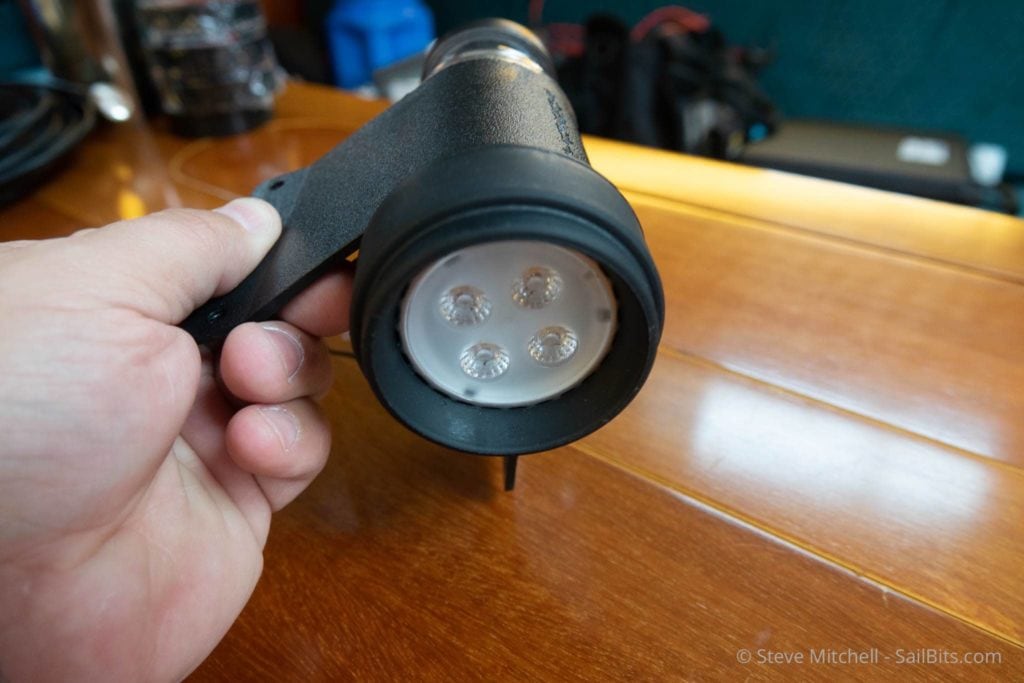
Wind Instrument
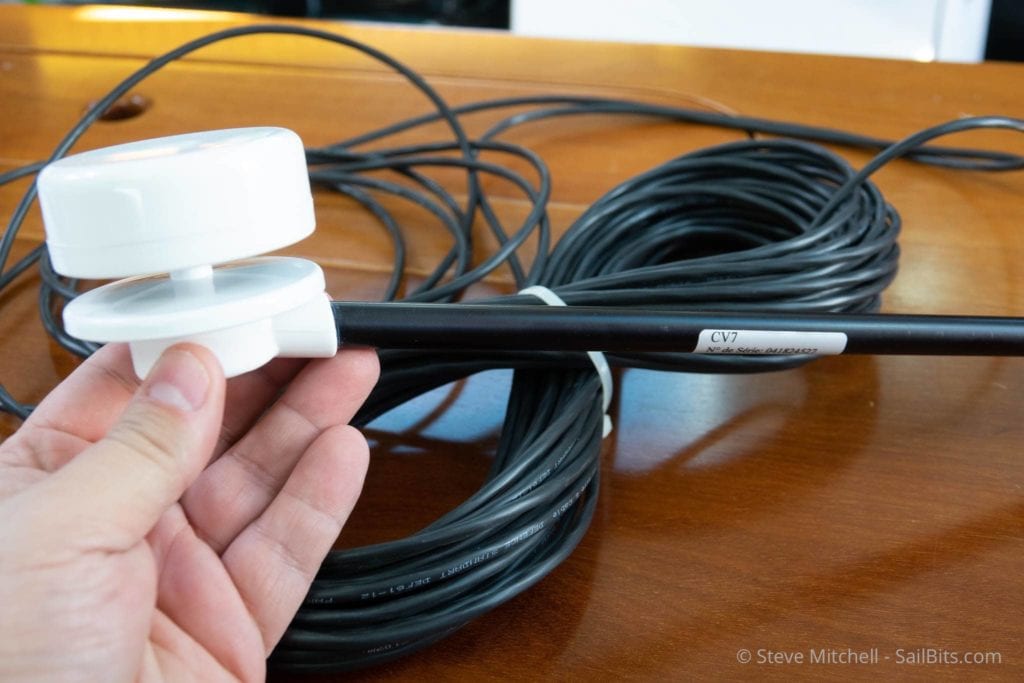
This was the subject of a number of discussions, including one on the new Marine Electronics Forums that I’m part of on Panbo. In particular, I was trying to choose between a wired or wireless sensor, and mechanical or ultrasonic sensor head. I ruled out wireless sensors after seeing the same challenges I had with the Tacktick system on Jammy – I did not want to deal with spotty reception or other issues for an instrument I consider to be pretty critical on the boat.
Wired seemed like the right approach, but should I go ultrasonic or traditional? I could have replaced the current sensor with an updated version of the Raymarine ST series, but that was expensive and still would have required some changes at the mast. Garmin’s gWind transducer has always been a favorite of mine because of its design with the dual tail fin and spinning front sensor like an airplane prop, but I didn’t want to have to also install a Garmin wind instrument at the helm just to update it.
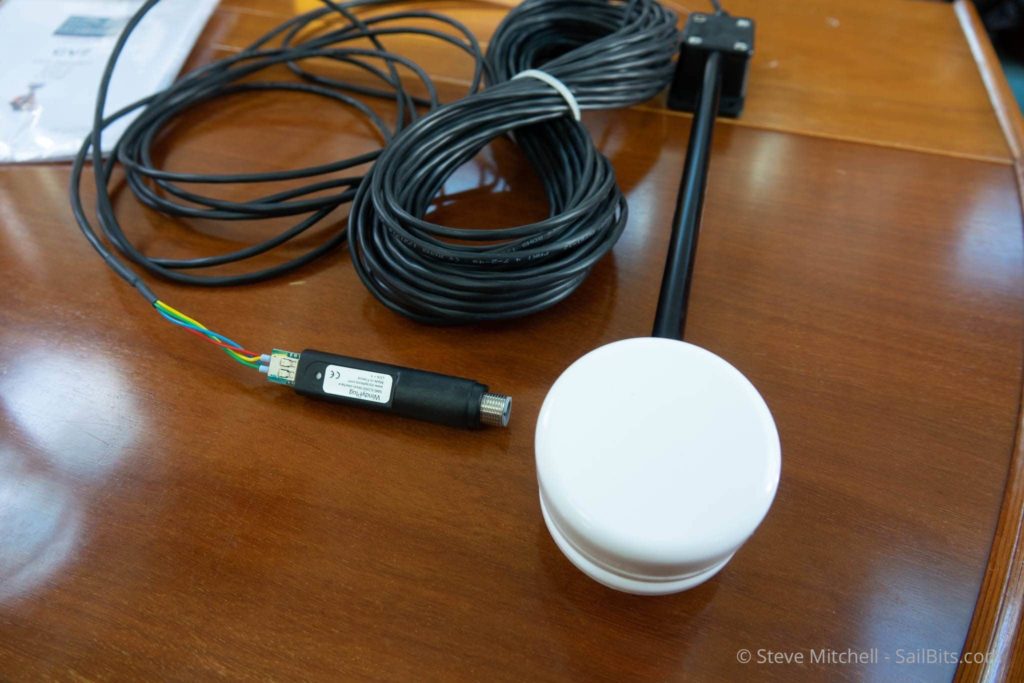
A bunch of conversations later, I arrived at the LCJ Capteurs CV7 ultrasonic wind instrument. Ben over at Panbo had a variation of the same instrument and seemed to like it. I had the Airmar and Maretron ultrasonic instruments on Jammy, but never liked how bulky they were. The Capteurs is made to be the same profile as a mast mounted traditional instrument, and has a thin wire to pull down the mast.
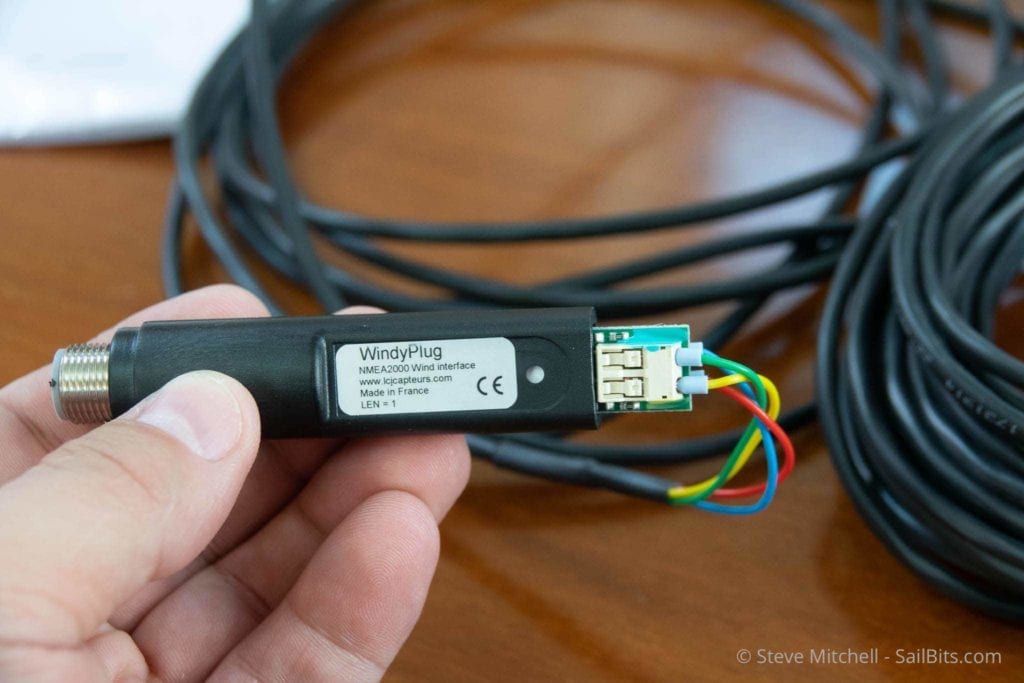
I also got the WindyPlug, which allows me to connect it to my NMEA 2000 network directly without any conversion and also get barometric pressure.
Flag halyard
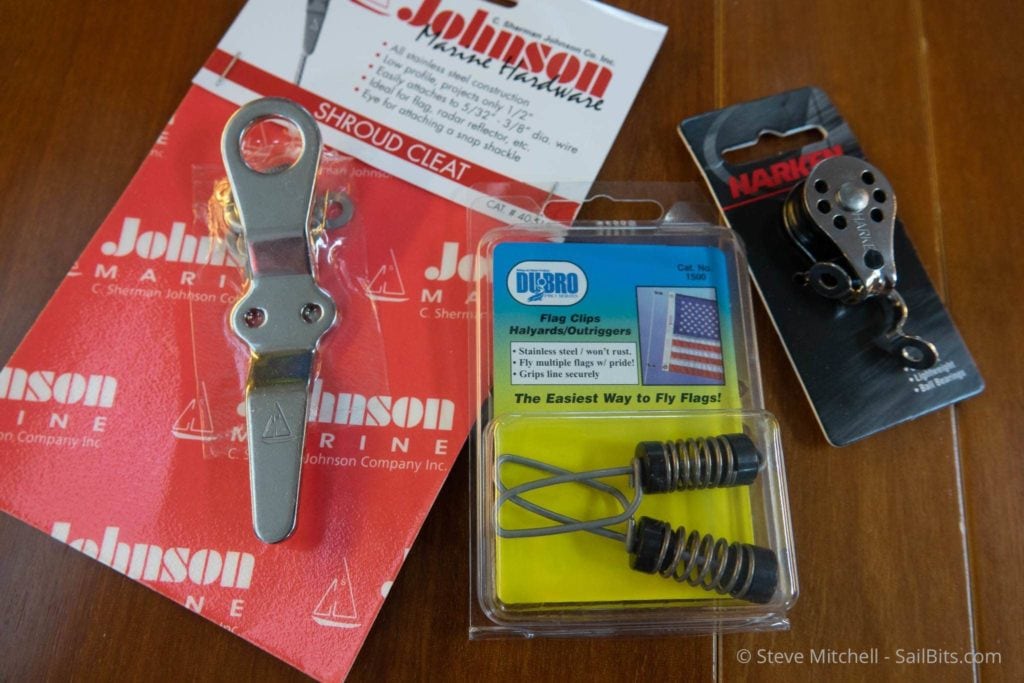
Grace did not come with a flag halyard, so I found a shroud cleat, a Harken block, some flag clips, and some paracord.
Other things
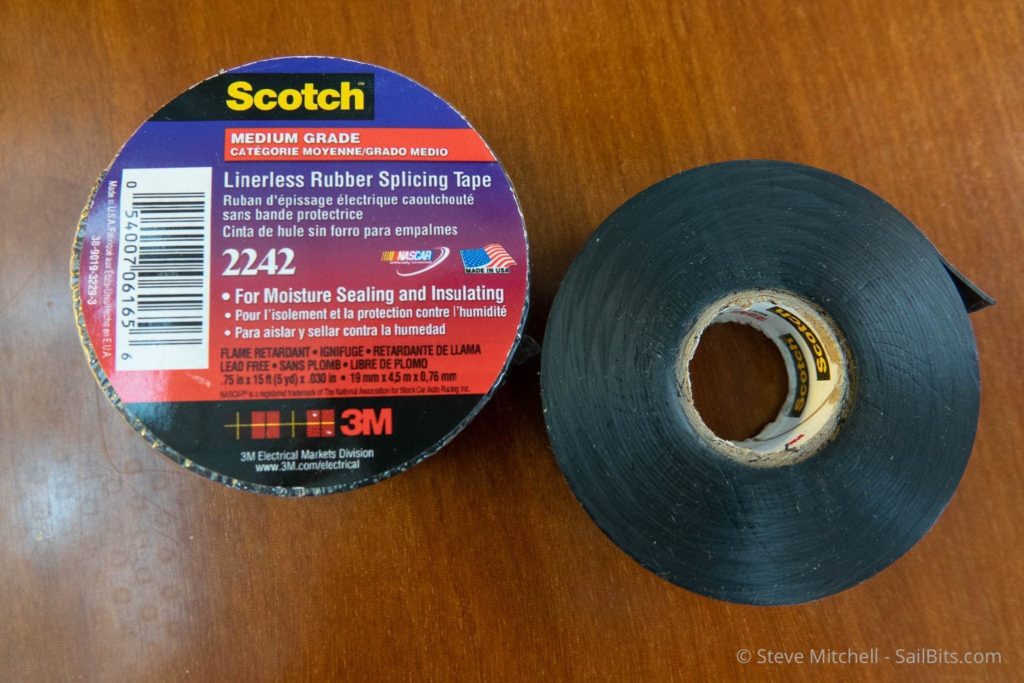
Besides the new instruments and items, there were some critical tools needed. One of the most important was rubber splicing tape which I used wherever wires touched anything else to provide chafe protection, as well as around the VHF antenna for waterproofing. It is extremely thick electrical-tape-like and similar to sail tape.
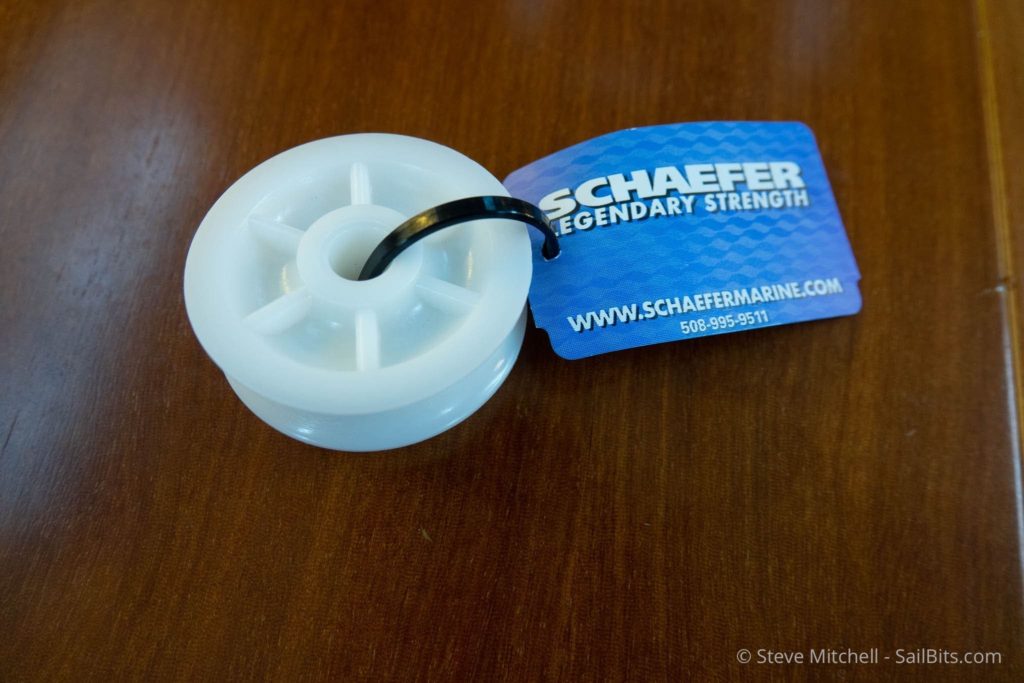
I hoped to replace the sheaves at the top of the mast since I had it down. I grabbed a few different types and sizes based on forum information on my mast.
I also tried to grab every possible tool and connector I could think of just in case I found something strange while I had the mast down.
Un-stepping the mast
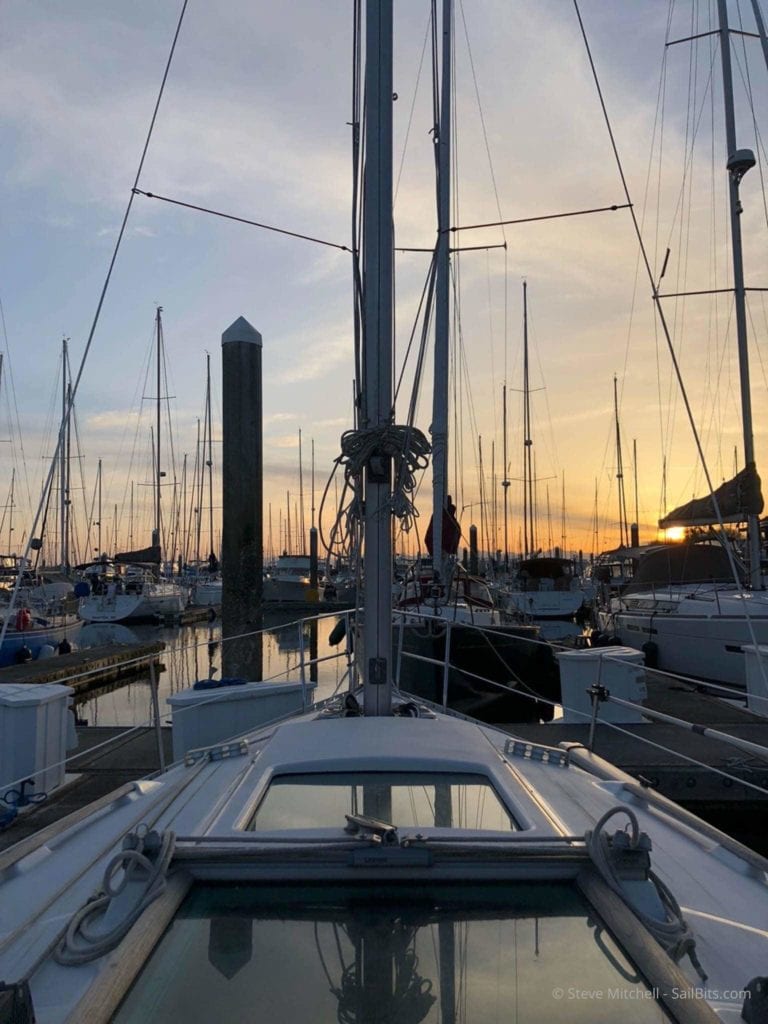
Getting the mast off was quite a lot of work. Besides the actual removal of the mast, I spent multiple days ahead of time removing the running rigging, sails, labeling everything, marking the standing rigging points, and generally cleaning up the deck in preparation for the mast removal. This was by far the longest part of the entire job!
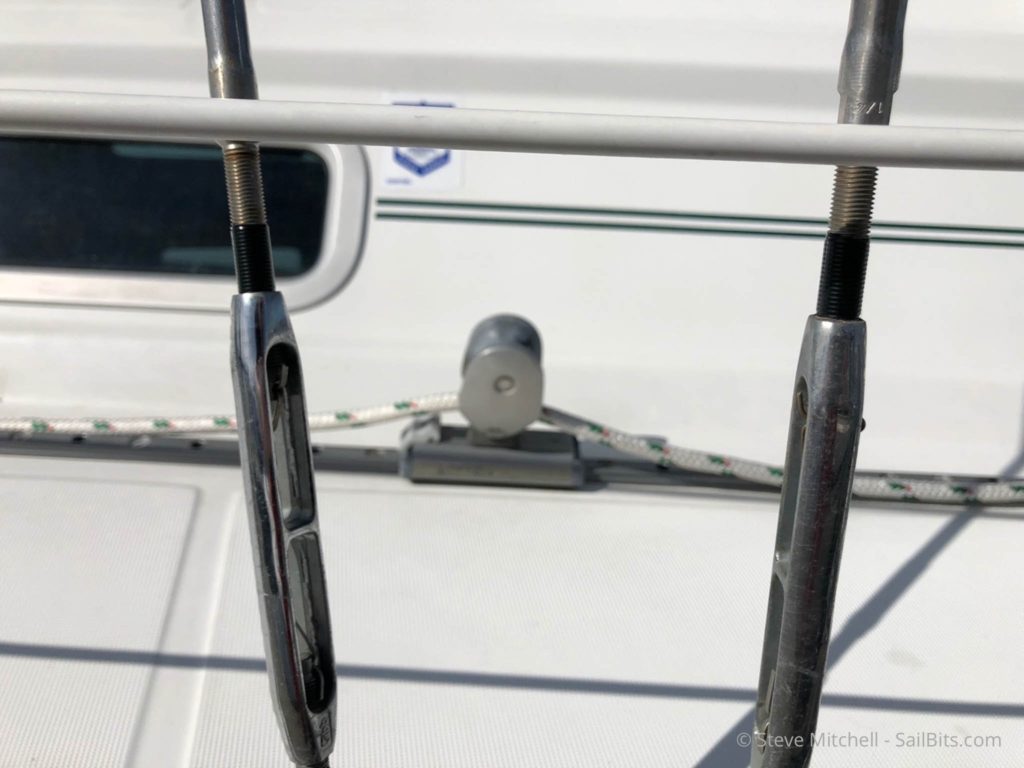
One important thing I always recommend is to mark your rigging before removing it. I used black electrical tape and it saved tons of time when we were stepping the mast a few days later.
Once that was done, it was a quick trip up to Seaview near Shilshole Bay Marina. After prepping the rig for about an hour, the guys came over with the crane, grabbed the mast, and away she went!
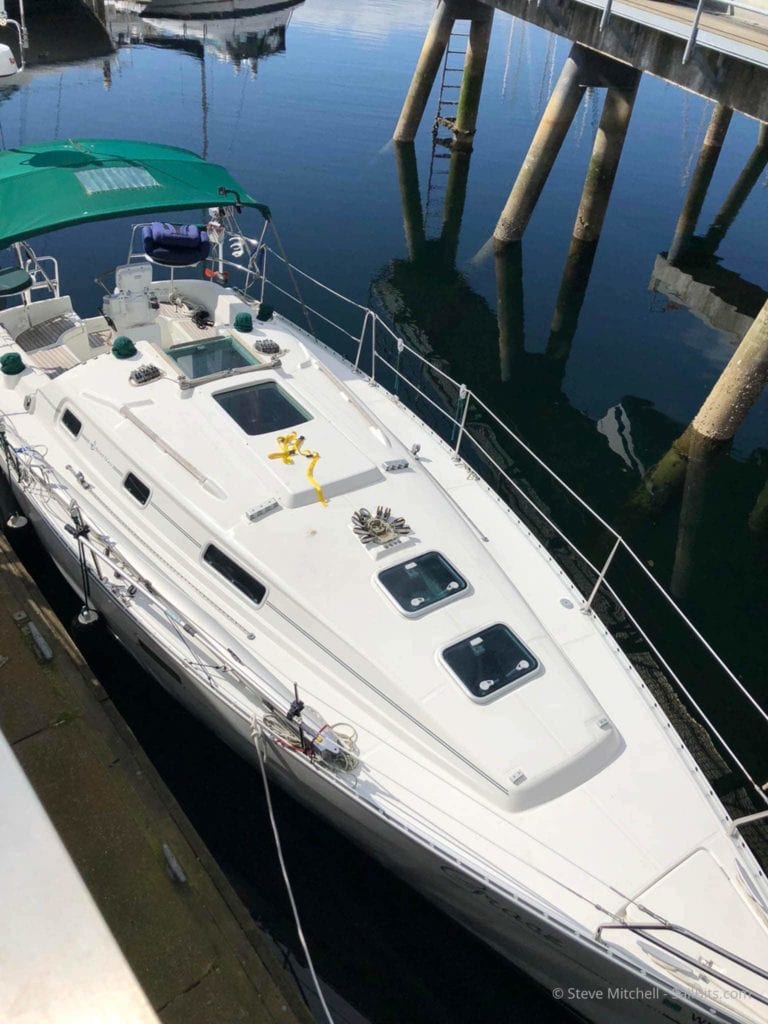
My plan was to work on the mast Tuesday afternoon, Wednesday all day, and Thursday morning to complete all the work. I was going to stay on Grace (minus the mast!) at nearby Shilshole Bay Marina to keep my commute times down, and do the work all myself. Shilshole was nice enough to put me in a slip right on A dock instead of their usual guest dock so I had a really short walk to the yard. That saved me a lot of time and back pain carrying my tools and junk back and forth.
Removal
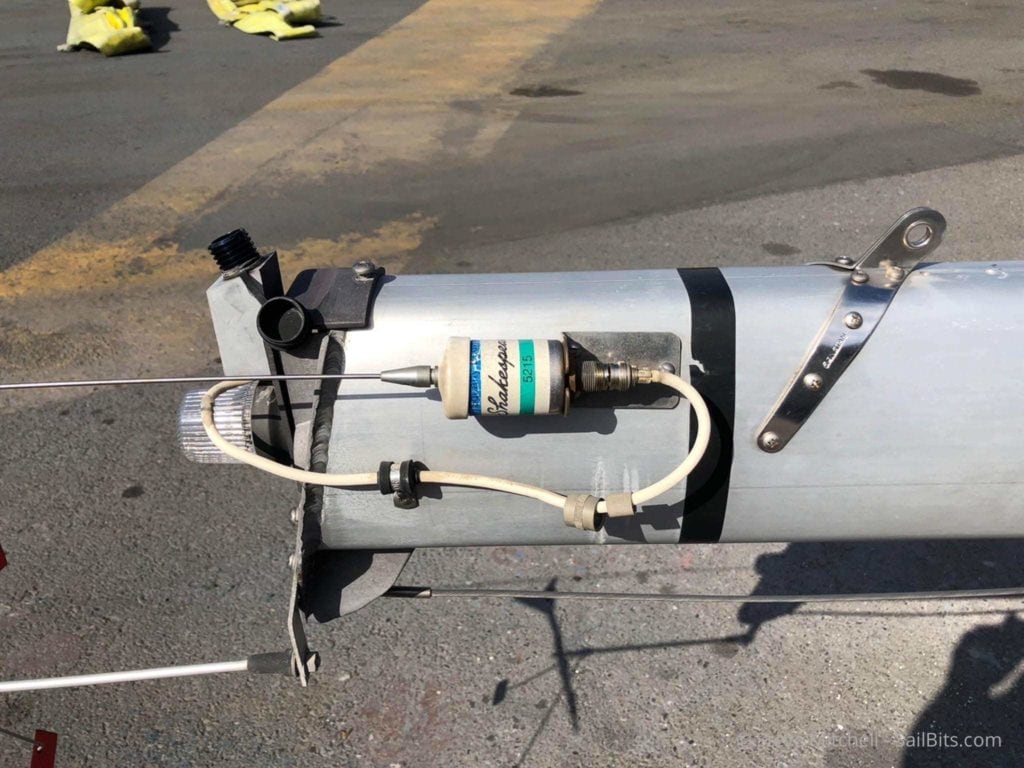
The first step was taking lots of pictures and then removing all of the old stuff.
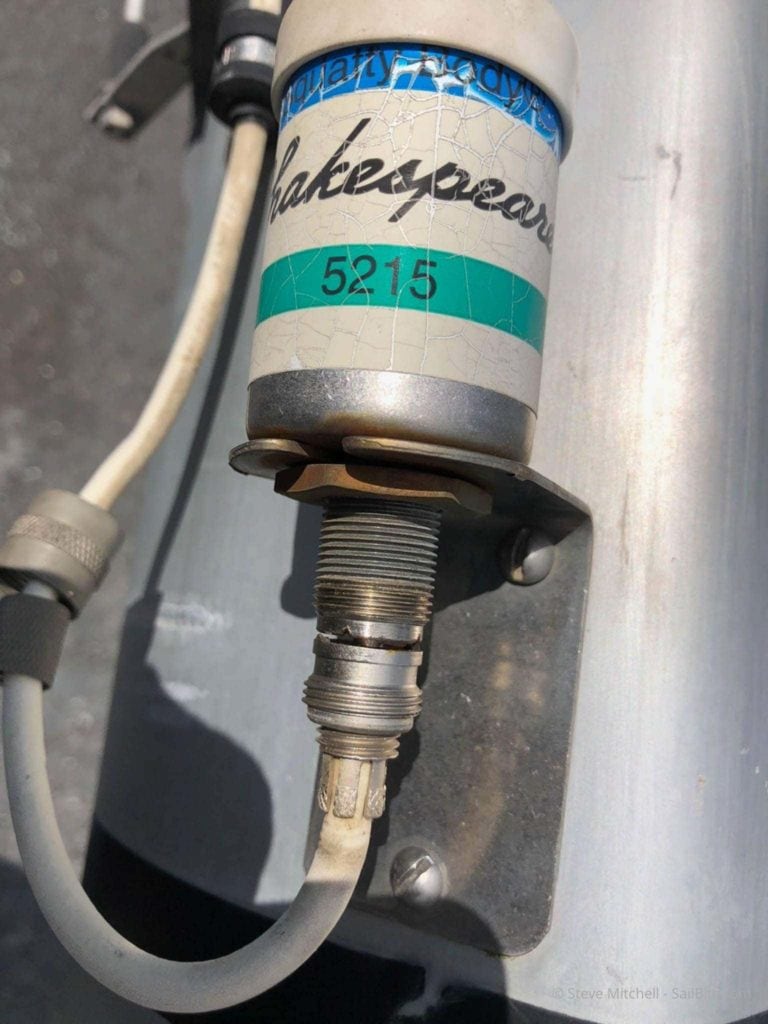
The old antenna looked OK, a bit old of course, but the wiring was the big problem. As suspected, whomever wired it last used a crimp on VHF connector. I have covered my mistakes in choosing these in the past, and how easy it is to do a much better job. Cutting the cable jacket away, and you could clearly see corrosion within the inside of the wire as far as I could see.
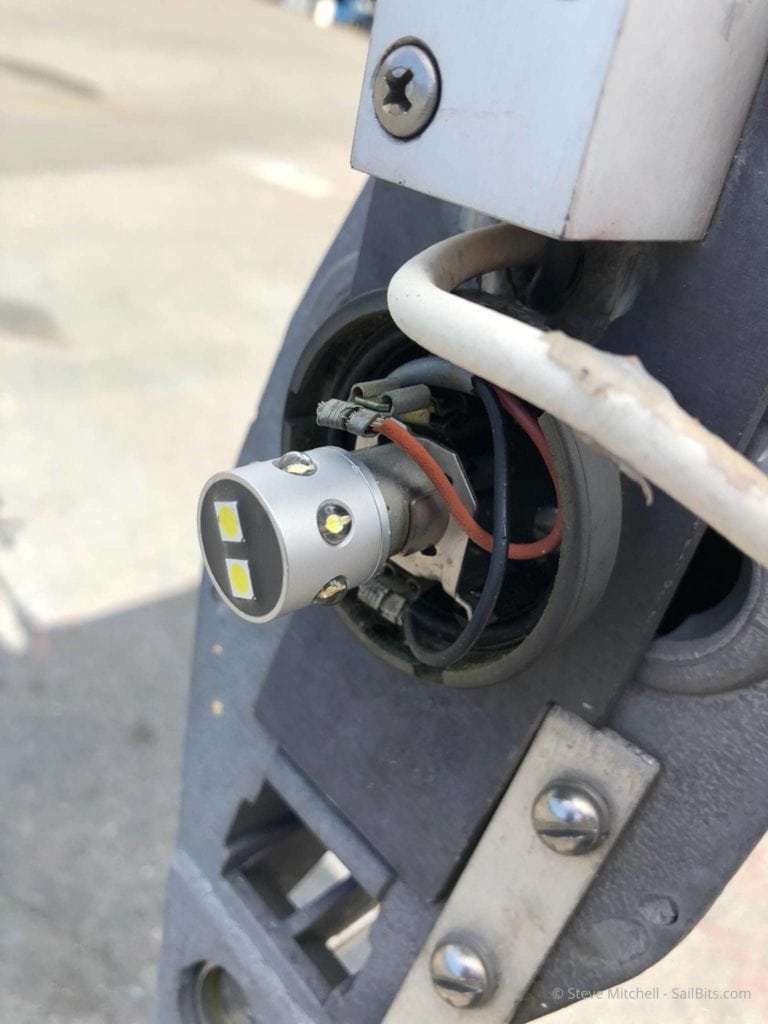
The anchor light looked OK, although I have never seen one like this. It looks like the original incandescent bulb was replaced with an unknown LED one at some point. I could not find any manufacturer information on the bulb, but the anchor light was made by Hella, and looks like the factory casing. I tested the wiring and light, and it looks like there is a short somewhere in the light.
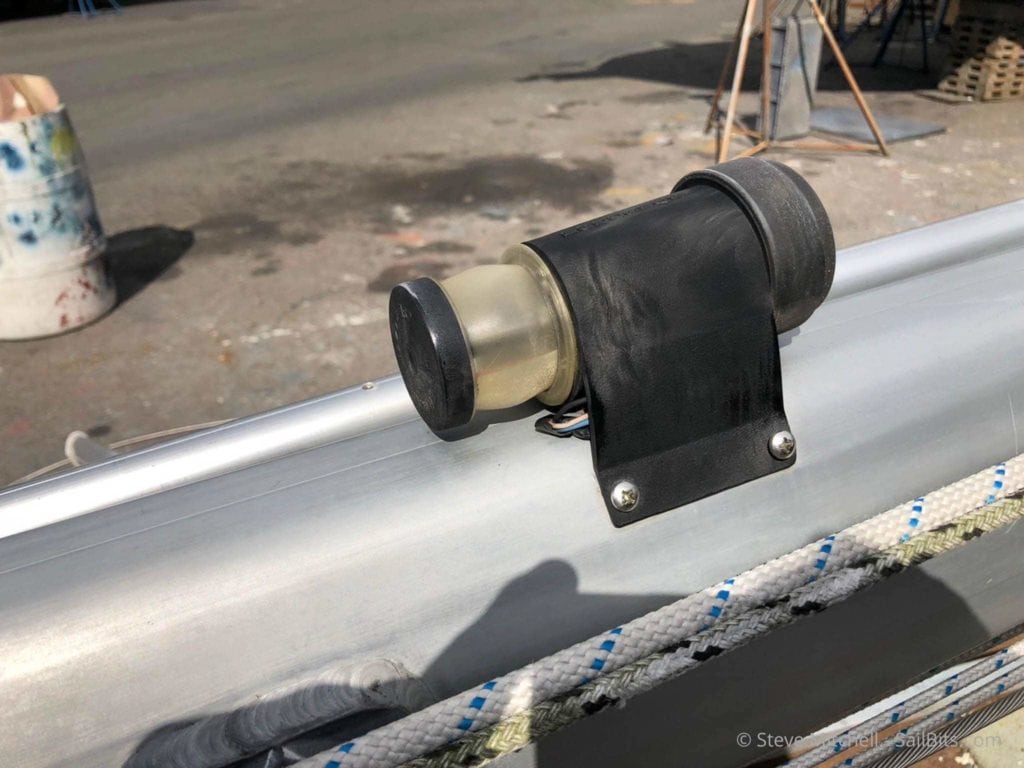
The existing steaming/deck light was actually the same exact light I had just purchased except that the new one was LED. How convenient! I bet the screws would match…
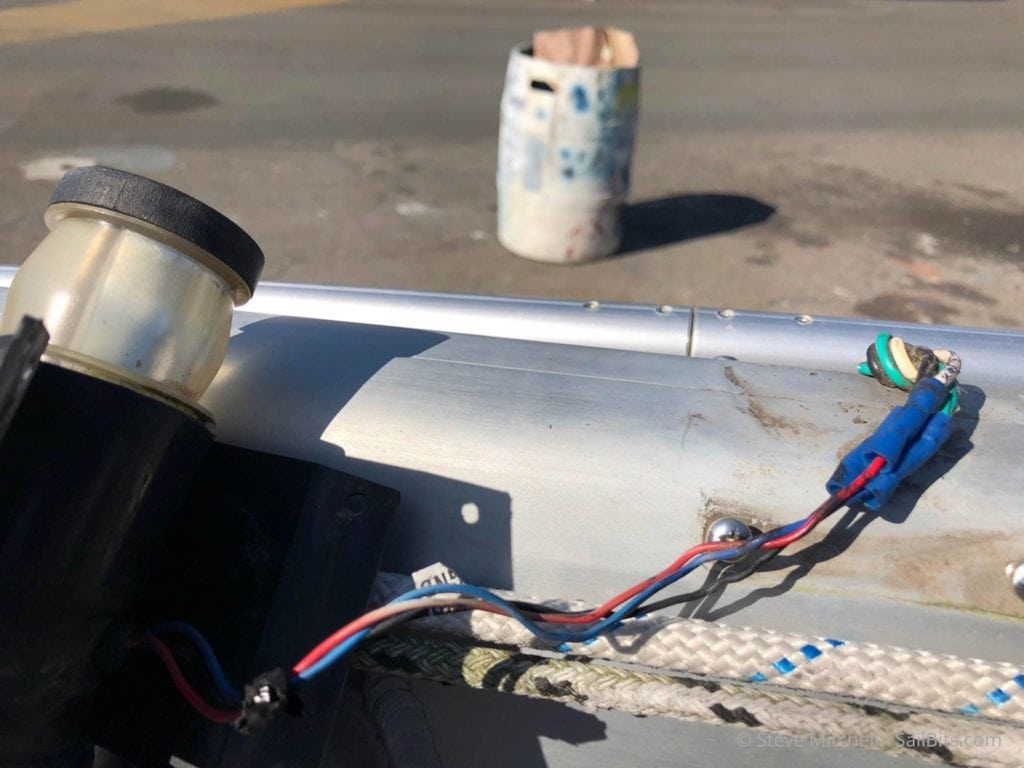
On top of using a home extension cable, the wiring to the steaming/deck light was connected using automotive crimps. I bet this is why the light doesn’t work…
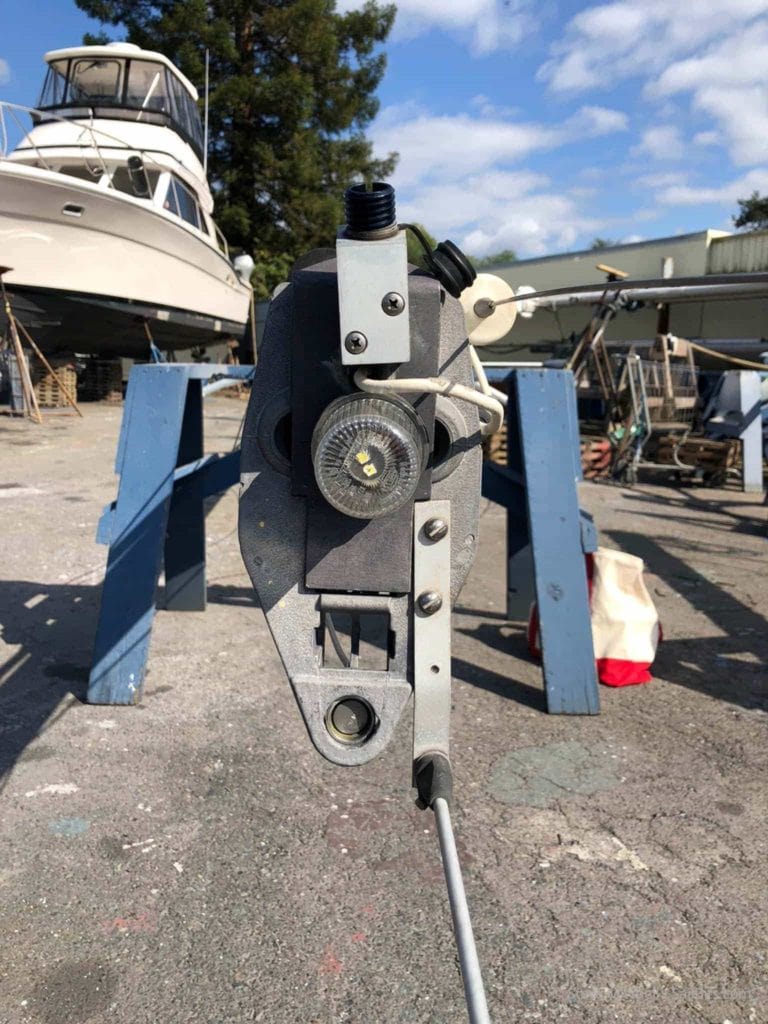
The space at the top of the mast looked compact, but I was pretty sure I could fit all of the new stuff up here.
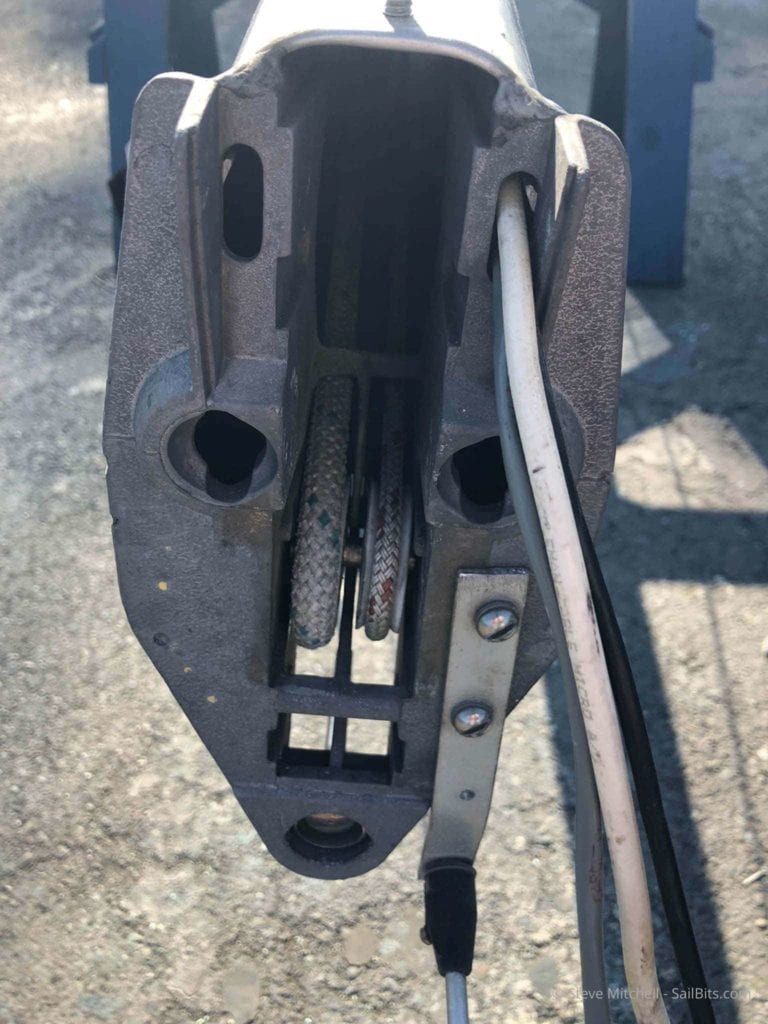
The sheaves at the top looked in very good condition, which is good because the ones I bought ahead of time were the wrong size.
Nothing about the rest of the rig or mast looked damaged, old, or in need of attention, which was awesome. The rest of my plans matched with reality as far as I could tell. Time to start the rewire!
Rewiring
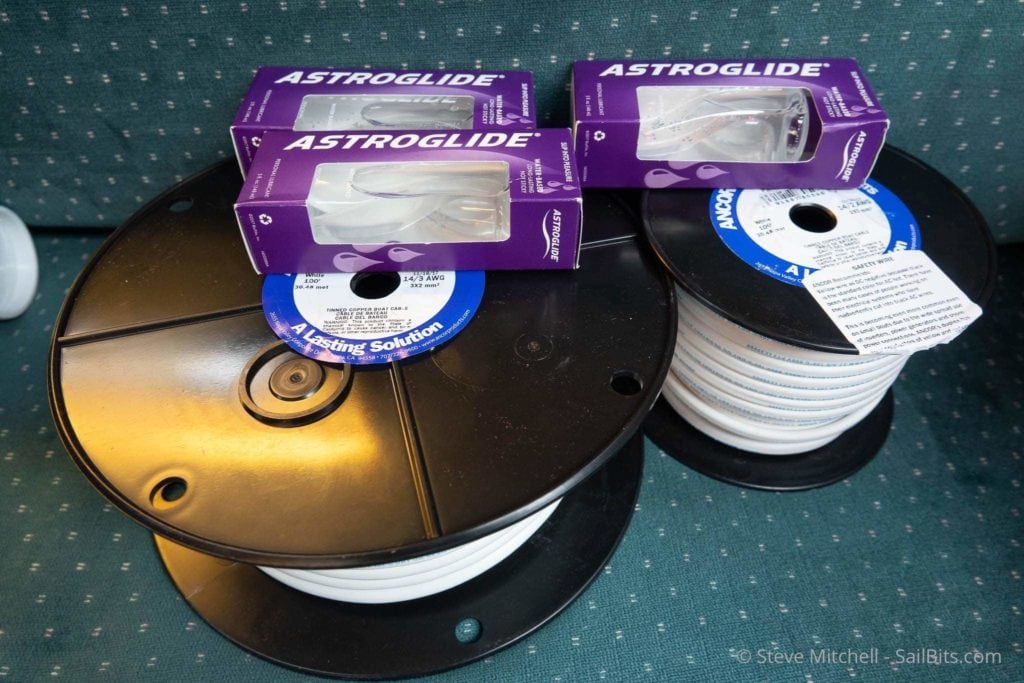
I know I got some odd glances when I was pulling new wire and using Astroglide, but it works! Some people us dish soap, but I find that Astroglide leaves less of a mess and works a bit better.
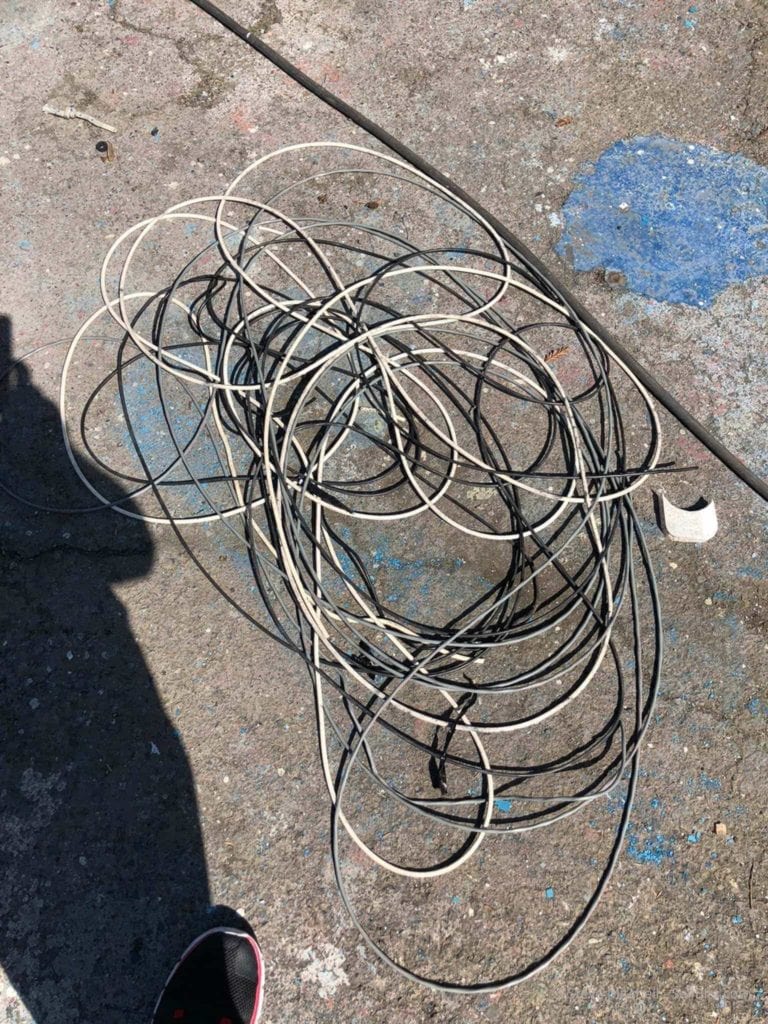
I used the old wiring to pull the new ones through. From the top of the mast, there was a PVC conduit that ran in the corner of the mast all the way to near the bottom. I was pulling three new cables, and there were three old cables, so I attached each to a matching one, threw some Astroglide on the new and old cables, and pulled them all through. I was mostly worried about this part of the work, but it was done in less than 30 minutes!
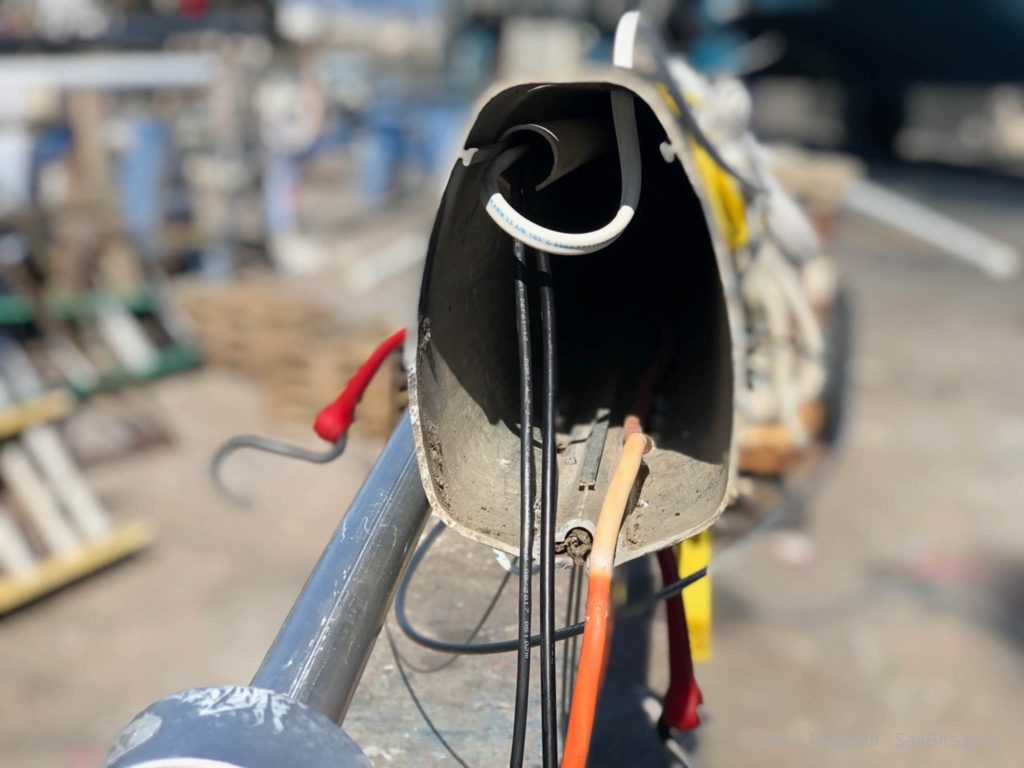
You can see the sharp turn things take before they exit the mast – this would have been very difficult to deal with while the mast was up. You can also see the orange extension cable that goes up to the mid mast location and the steaming/deck light. The other three cables are for the anchor light (white safety duplex), VHF LMR-195, and thin wire to the LCJ Capteurs wind instrument.
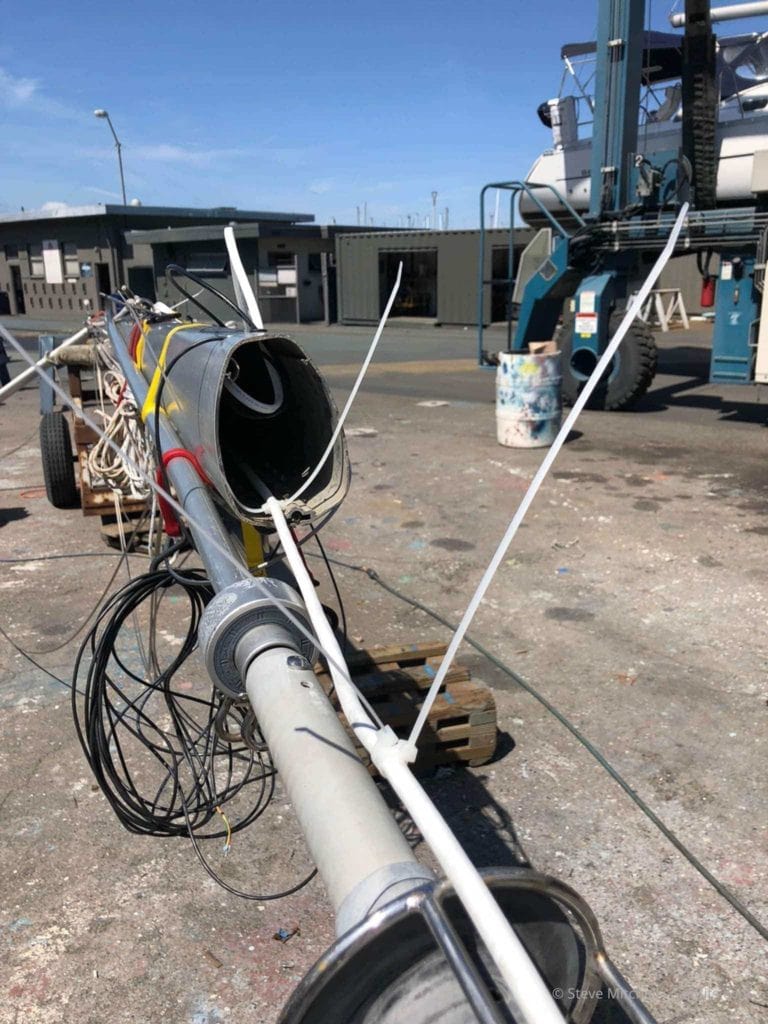
For the mid mast spreader/deck light, I used a trick that I had learned from a previous boat and mast. I attached zipties and left their tails on, pulling the wire in slowly. The zipties should keep the wire from slapping around inside the mast, at least most of the time. I used 3 strand wire for this light so I could have control over the steaming and deck light separately.
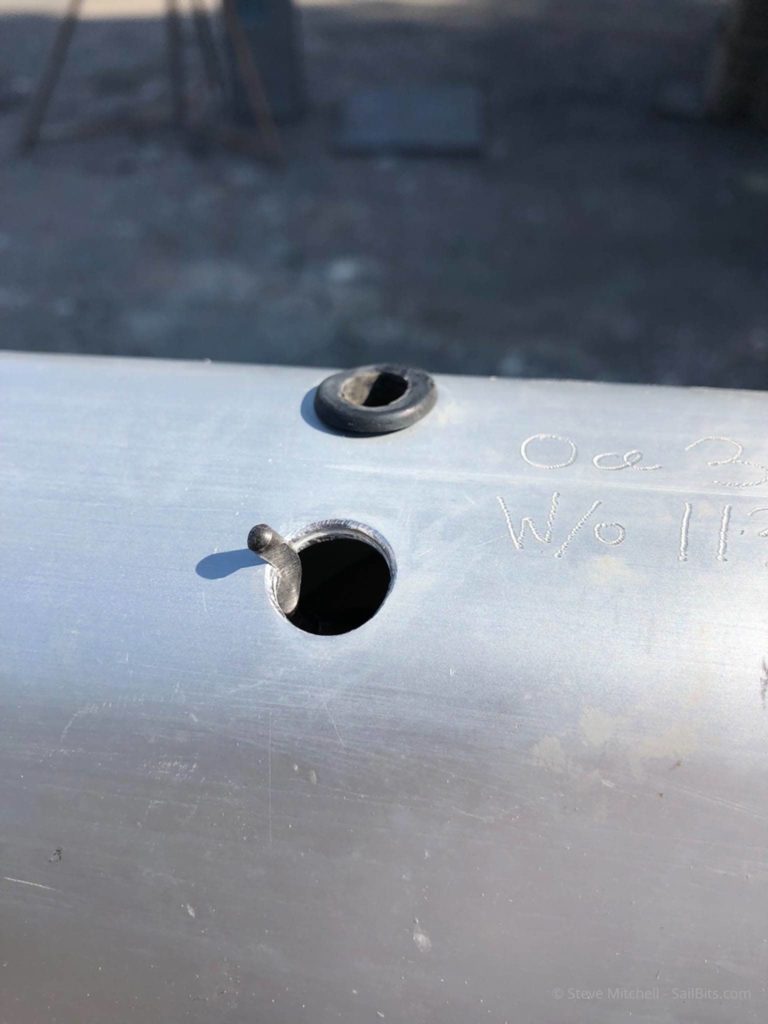
I used my deburring tool on the wire exit holes at the bottom of the mast and made sure there were no sharp edges. Even with a grommet, I prefer doing this as the grommets eventually fall out at some point, and I didn’t want the wires to be damaged. Surprisingly the factory holes were quite sharp, even after all this time.
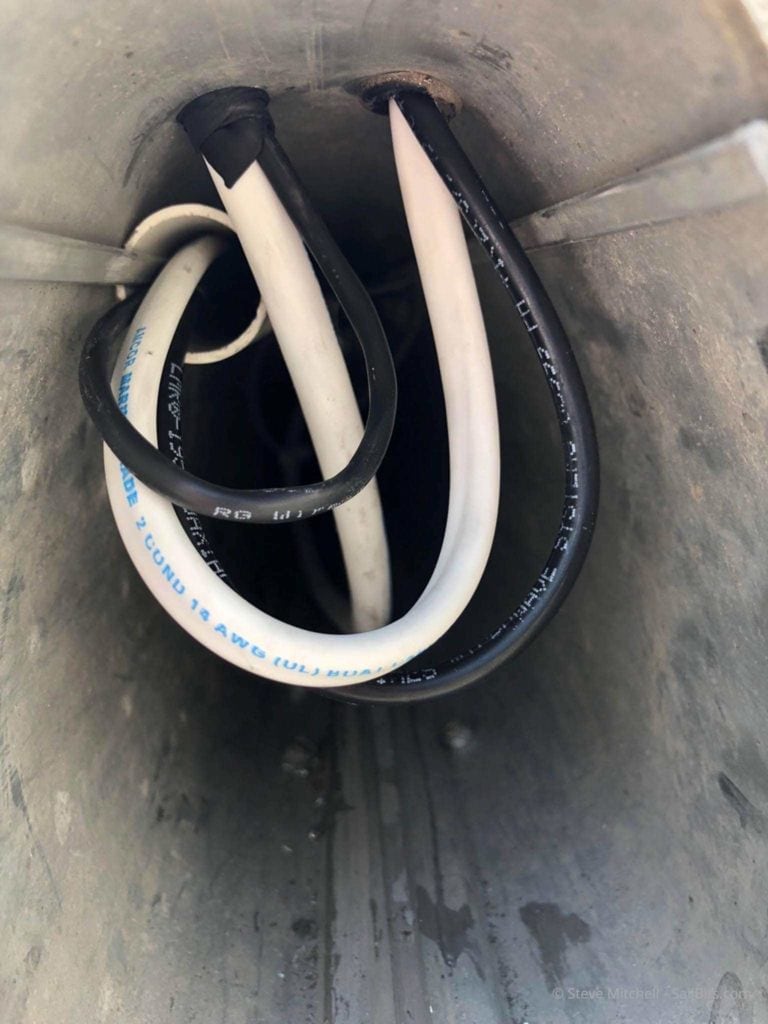
All four wires were now in, and as I said, quite quickly. I left a nice service loop at the bottom, and sent things out the two holes. You can see the three wires headed to the top of the mast on the left hand side going up the PVC, and the zip tie tail wire in the middle.
Installing the toys
With the wires in place, it was time to connect everything together.
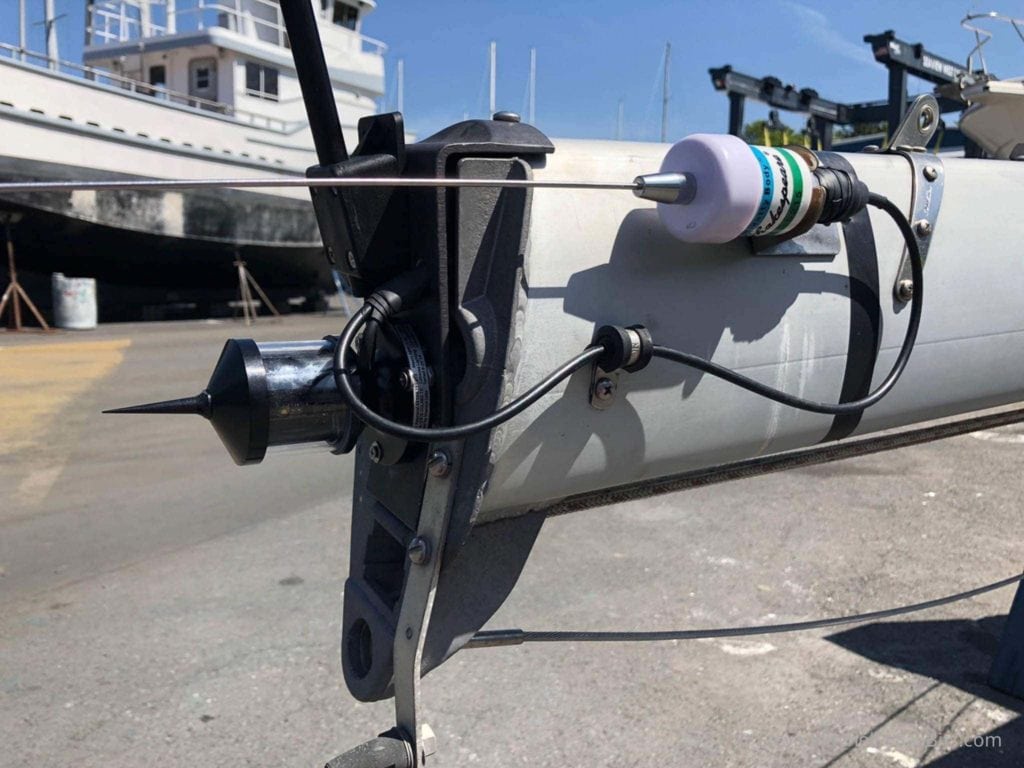
I was able to re-use the existing VHF bracket and install the new antenna. I also used the super thick rubber splicing tape both to cover the connector at the bottom of the antenna, and wherever the wire went through a grommet or holding device.
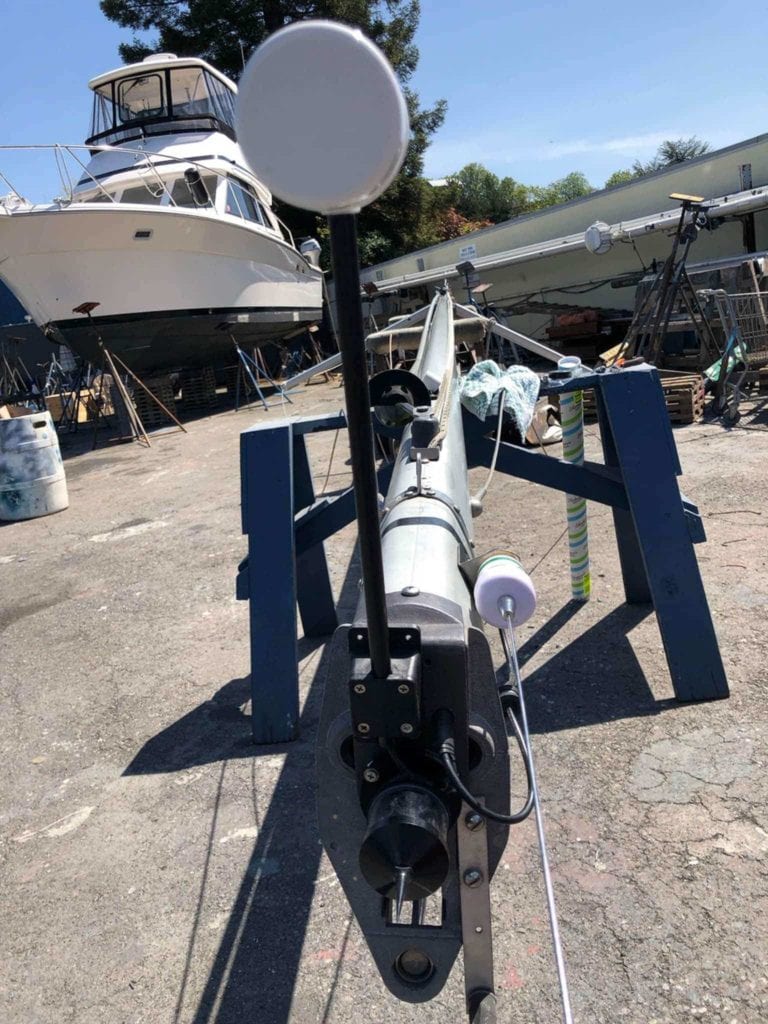
The anchor light required a bit of futzing to fit in the space, as it was slightly bigger than the older one. I did not connect all three wires from the anchor light, only the positive and negative for it to be used as a normal anchor light. There was a third wire that could be used to flash an SOS or emergency signal, which I didn’t feel I would ever use. I also didn’t want the additional space challenges in running that many wires to the top of the mast.
The LCJ Capteurs CV7 ultrasonic wind instrument fit in the space vacated by the big hunk of aluminum that came with the Raymarine ST60 wind instrument. It was extremely easy to orient correctly, and was ready to go.
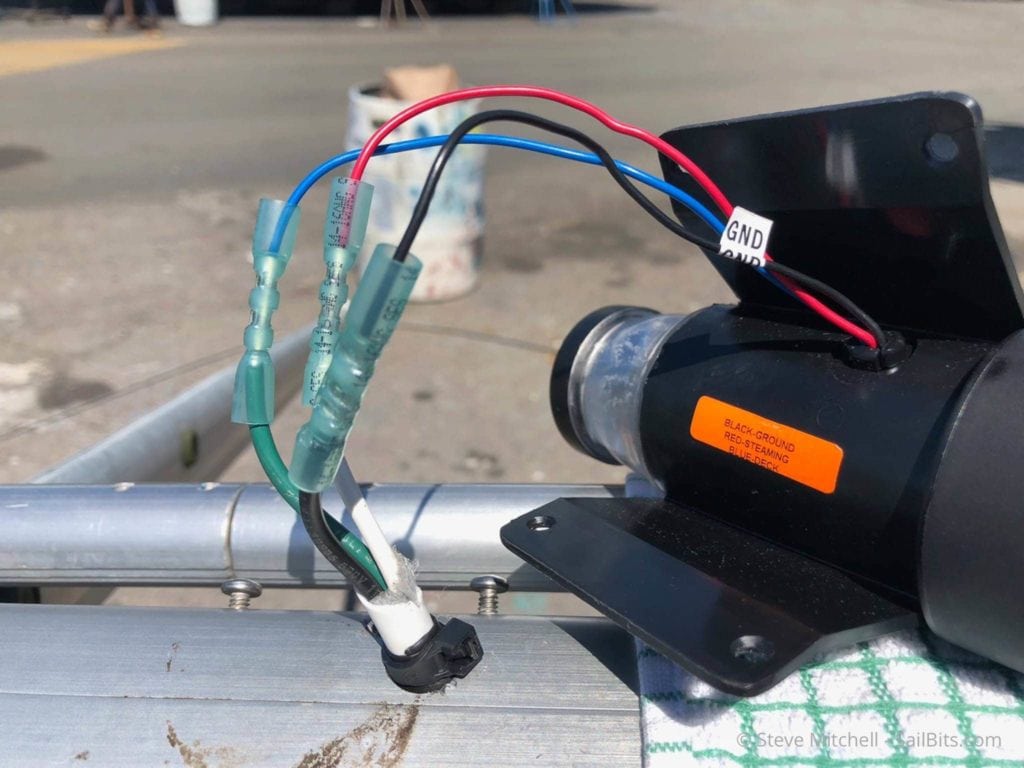
For the steaming/deck light, I had a bit more of a challenge getting the wire out of the mid-mast hole, but using some trickery with small gauge steel wire, I fished it out and connected things up. This is before I used my Dremel torch to close down the shrink wrap, but I’m happy that I have the ability to control each light separately.
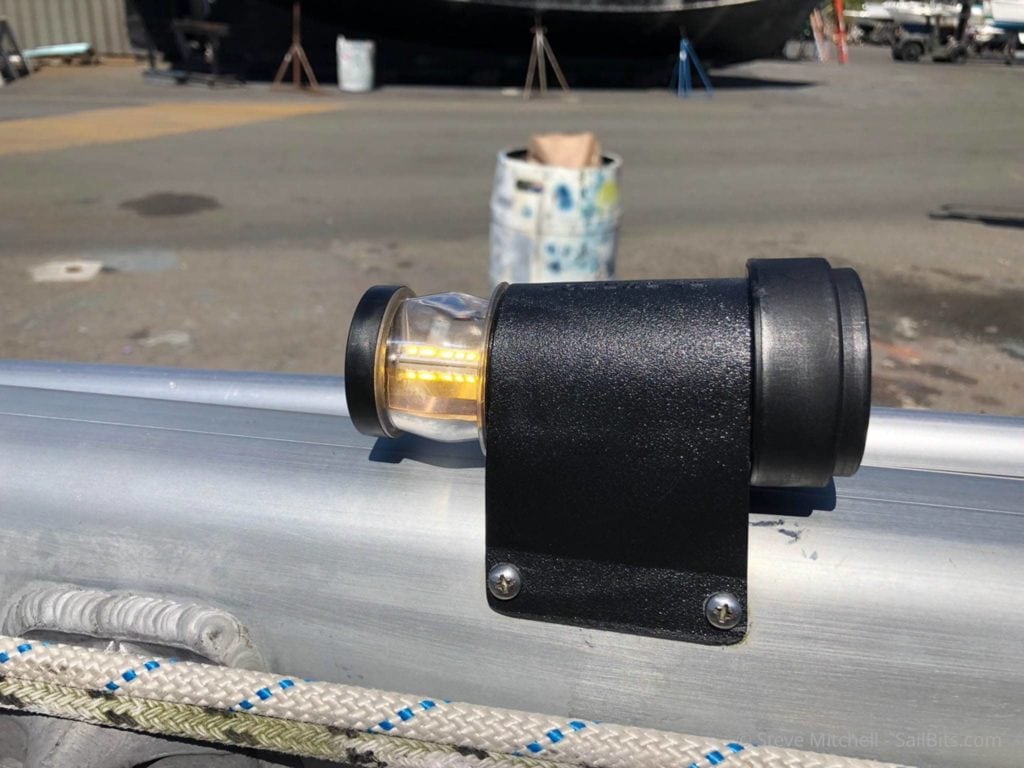
The new light was a carbon copy for the old one, and the screws fit perfectly!
I used my Noco jumpstarter as a portable 12v power supply so I could test the lighting.
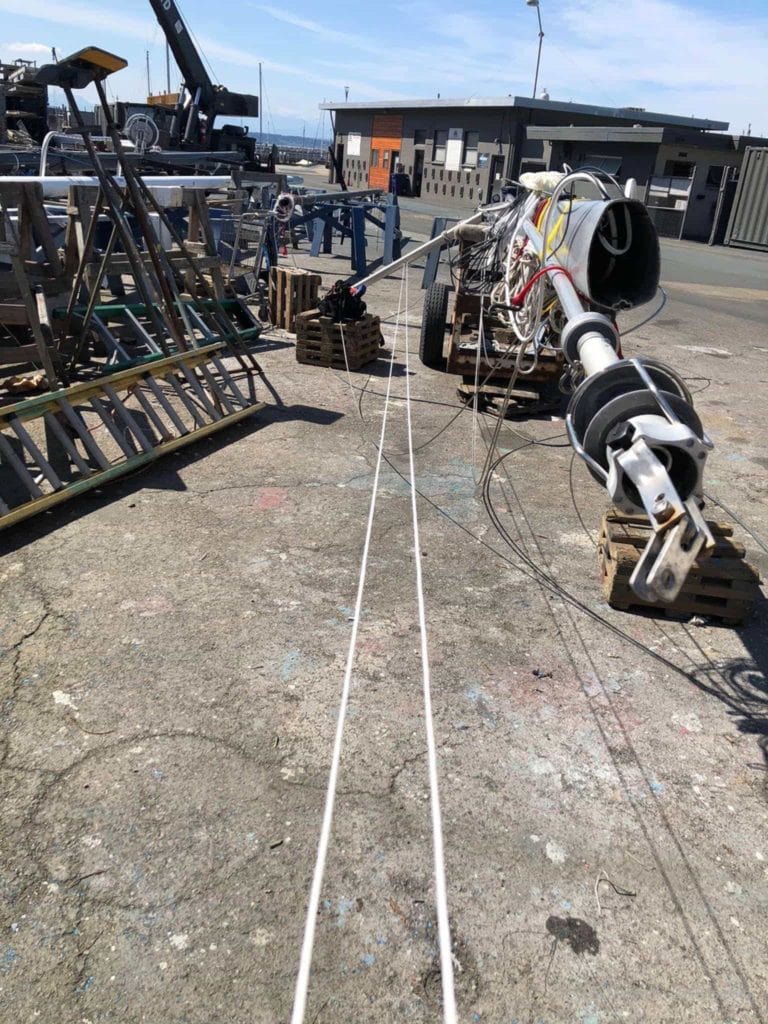
I didn’t take any good pictures, but I was able to install my new flag halyard within about 30 minutes – a couple of holes tapped into the bottom of the spreader, attach the block, and run the paracord.
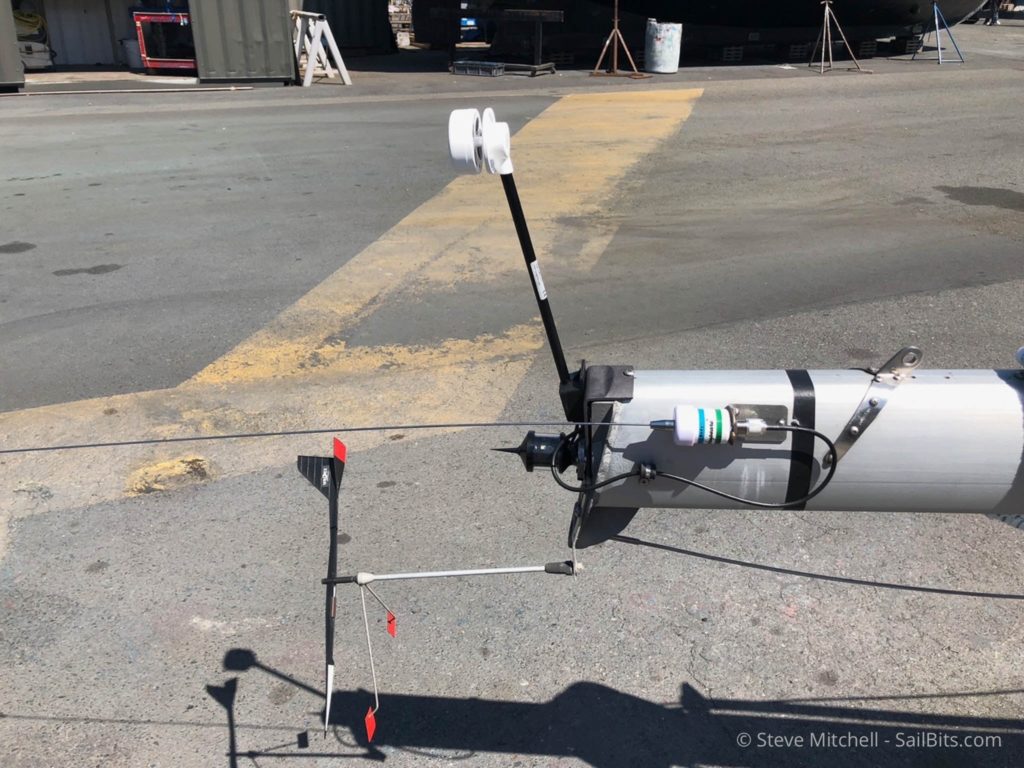
I was very happy with how everything came out – I completed all of this work in a day, and had the second one to tidy things up and recover from a long day in the hot sun!
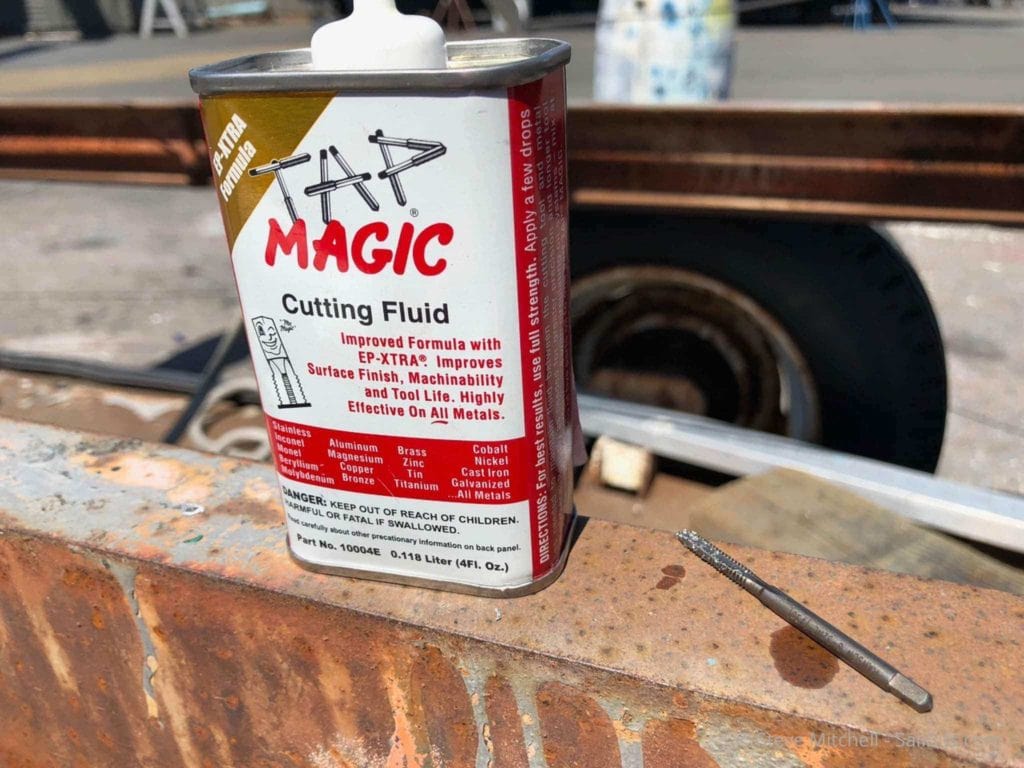
When attaching everything, I used a smaller drill to drill the hole, and a lot of tap oil. Once the hole was drilled, I used an appropriate sized tap, and again a lot of tap oil.
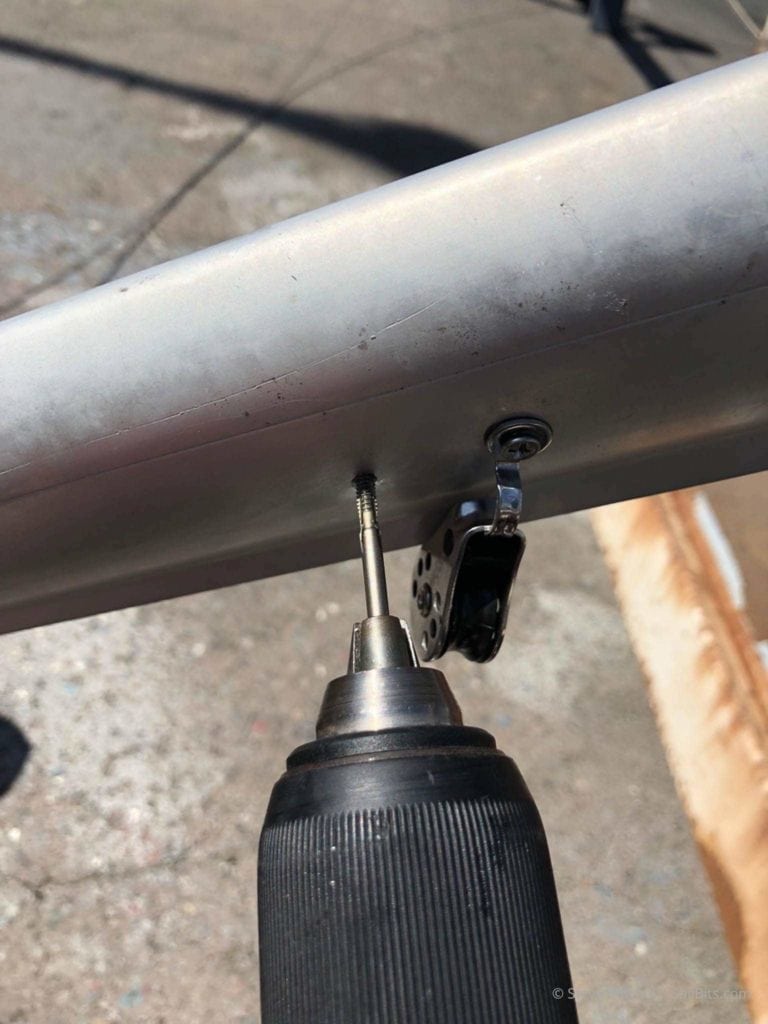
I prefer to use the tap in my electric drill instead of using a typical tap tool. I find that I am able to tap things more accurately this way, with the threads straight and true.
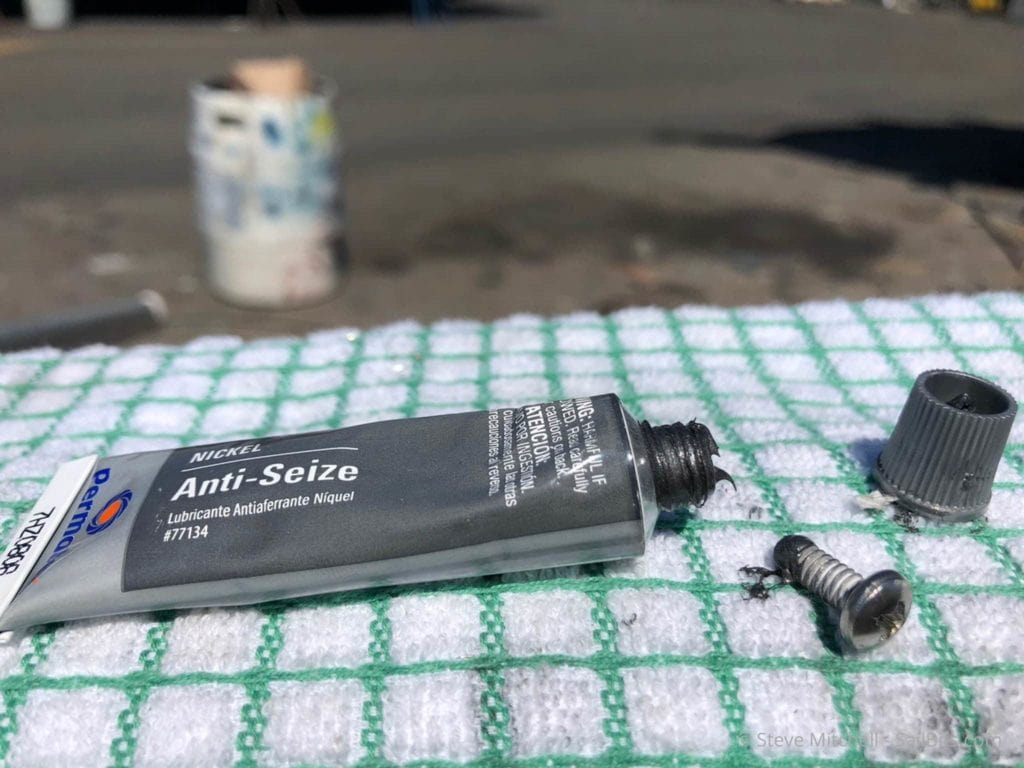
With any steel inserted into aluminum, its important to ensure you use anti seize to prevent galling, corrosion and seizing between the two disparate metals.
Overall, I made a minimum of new holes for things like the anchor light and wind instrument, while I was able to re-use the existing bracket for the VHF antenna, holes for cable holders and passthroughs, and exact match for the steaming/deck light.
Ready to put it all back together!
Stepping the mast
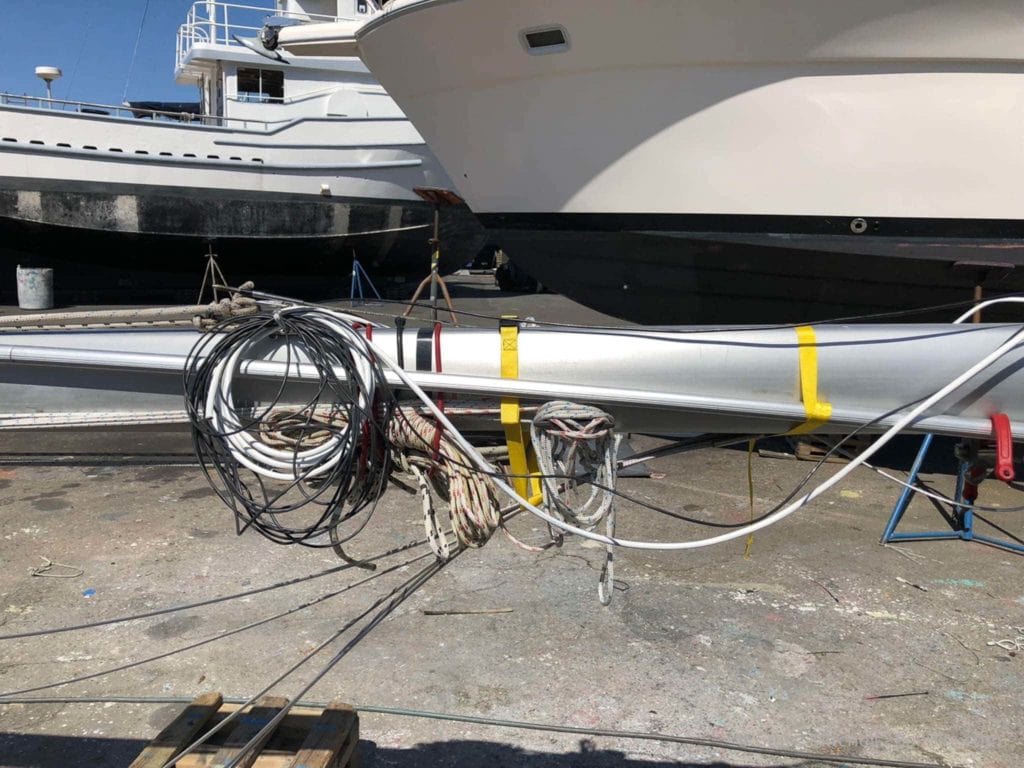
Once everything was done in the yard, and I had strapped up all of the wires and rigging ready to be put back up, it was time to call the crane.
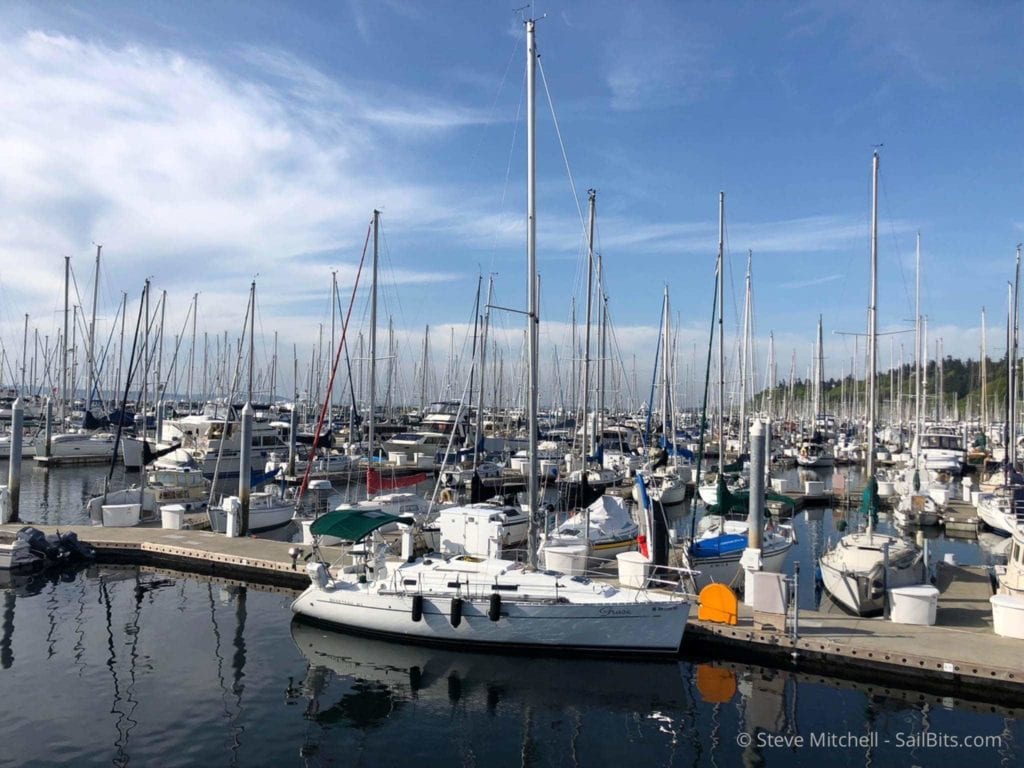
Getting the mast back up on the boat took a bit longer than expected. We fought the rigging a bit trying to get the spreaders connected, mainly due to the way the rig is canted towards the stern. After a couple of failed attempts to get the backstay connected, we realized the spreaders were more than enough to hold the rig centered, and adjusted our approach. It was still over an hour of messing with it before things were stable enough for the crane to depart.
After a bit of touch up, I moved over to A dock to rest and recover from a busy 3 days.
Reconnecting everything
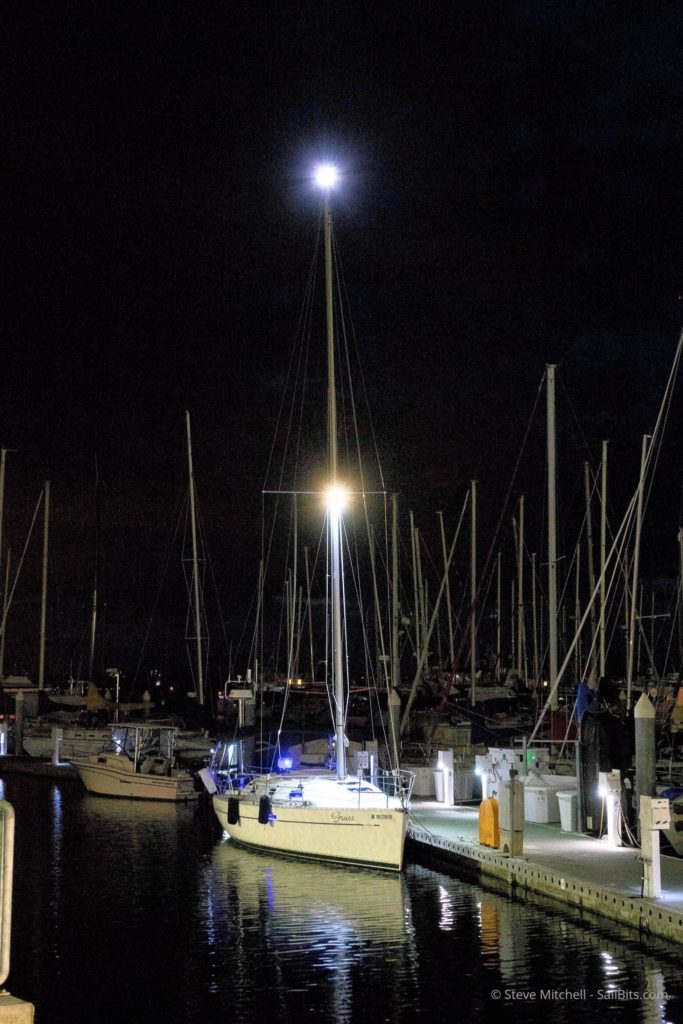
That evening, I was able fish the cables through to the navigation panel – it was one of the most difficult parts of the whole project because of the path they had to follow, but if that was the hardest part, I’m OK with it.
After a bit of testing, the anchor and steaming/deck lights were up and running, and looked beautiful on a calm night. I was able to wander up onto the docks and get a great picture.
The LCJ Capteurs wind instrument worked the instant I plugged in the WindyPlug. No configuration required, just beautiful wind data on the NMEA 2000 network.
The VHF radio lit up with more talk than I ever remember hearing. I left a service loop of the LMR-195 near the base of the mast inside the cabin just in case the mast has to come down – I could cut and splice it there if needed.
Tuning the rig
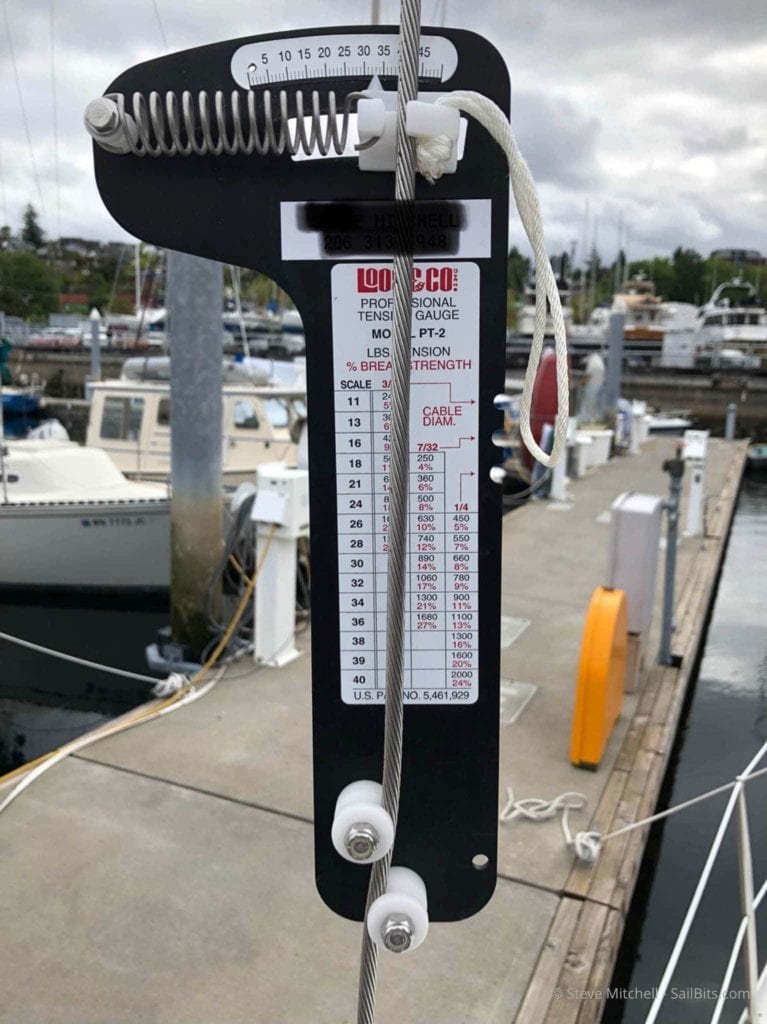
Before leaving Shilshole the next morning, I took the opportunity to tune the rig as best as I know how. Years ago I purchased and found it a great resource to learn how to do this.
I spent about an hour getting things almost right back to where they were before un-stepping, and was happy with the way things looked. The next few hours I spent putting the boom back on, re-attaching running rigging, and getting ready for the hour plus jaunt back to the home marina.
Results
Sailing home with with the rig back on and everything working the way it should was extremely satisfying. Even at this point, I could see great benefits in the work I had done.
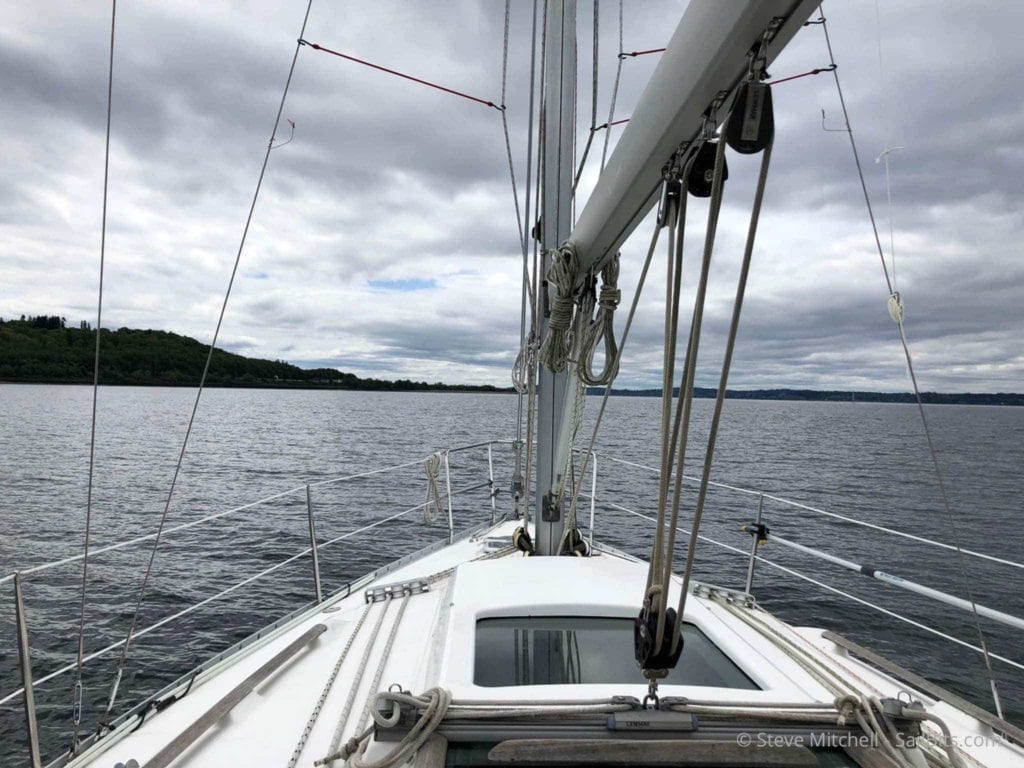
This work has been done now for about a month, and I can say it was worth every penny and bead of sweat lost.
The lighting now works the way it should have. My anchor light takes next to no power, is visible from the moon, shuts itself off at daybreak, and doesn’t cause any interference problems.
The steaming/deck light is also a pleasure to have working correctly. We’ve been out at least 3 times in the last month while under motor as the sun as gone down, and the steaming light has shone bright and true. Plus, I am not blinded by the deck light also being on since they are separated now. The crew loves the light (maybe not the temp – tis a bit clinical) on the deck – it is super bright even from the four LEDs, and makes it easy for tasks at night.
The LCJ Capteurs CV7 wind instrument is so much more accurate than the previous Raymarine system. I have been especially impressed with its granularity in light air, and have no complaints whatsoever. I will likely do a deeper dive on the instrument itself, how it presents itself on a NMEA 2000 network and to MFDs, wiring, and a discussion about apparent/true wind and support.
The most surprising thing is the VHF antenna and wiring improvements. I ran a single cable from the antenna all the way to the radio – no joint in between. The new antenna, properly sealed connectors, and high quality cabling gave astonishing results. Not only could I transmit and people actually hear me from quite a ways away, but what I could hear was amazing. From my slip in Elliott Bay Marina, I can routinely hear boats as far north as Edmonds, and as far south as Tacoma. Most of them are Washington State Ferries, but I also hear pleasure craft, bigger ships, and much more. I even heard S/V Lutris all the way across Elliott Bay on a low power channel asking to have a bridge opening. By far, this was the best improvement in doing this work – having a much more reliable VHF radio to hear and be heard will bring peace of mind in the event of an emergency.
All told, it was several weeks of scrambling to get things together, a week of really hard work prepping, 3 days of hot work in the yard, but worth it! I hope that I don’t have to take the mast down again for many years to come.

